

Kent Quarterly



Gunn Cross Once Again
Numeral Rock
Larry Gile ’73
32 Catching up with Seth MacFarlane ’ 91 by Jana Brown
24 Be Like Mike Remembering Michael A. Wright ’81 by Megan Tady
28 Engineering with Purpose
Kent by Megan Tady
KENT QUARTERLY SPRING/SUMMER 2025
VOL. 41 NO. 2
The Kent Quarterly is written, edited, and designed by the Kent School Marketing & Communications Office and is produced for alumni, parents, and friends of Kent School.
Editorial Manager
Marisa Scarnati
Director of Marketing & Communications
Kirsten Cheney
Digital & Social Media Specialist
Mackenzie Collyer
Communications Manager
David Head ’10
Creative & Print Services Specialist
Chelsea Hunter
Photography & Videography Specialist
Jimmy Ji
Contributors
Katy Armstrong (Hon) ’70
Jana Brown
Christina Cumberton P’24
Larry Gile ’73
Michael G. Hirschfeld (Hon) ’94
Denny Mantegani (Hon) ’58 ’62 ’67 ’72
Marya Neary P’25 ’28
Robert Ober Jr. ’54
Megan Tady
Cover image
Pamela Littky
The Kent Quarterly invites contributions, letters to the editor, and feedback at kentcommunications@kent-school.edu.
Update your contact information: www.kent-school.edu/alumni/update-myinformation
Share a class note: www.kent-school.edu/class-notes
Kent School adheres to a long-standing policy of admitting students without regard to their race, color, ancestry, national origin, religious creed, sex, disability, genetic background, sexual orientation, gender identity or expression, or any other characteristic protected under federal law or Connecticut state law. Kent School also does not discriminate on the basis of any such protected characteristics in administration of its educational policies, financial aid decisions, employment practices, and other School-administered programs.

Did you know you can read the Kent Quarterly online? Visit www.kent-school.edu/quicklinks/kent-quarterly or scan the QR code above to access the digital edition or explore past issues.
From the Head of School
As I was leaving Mattison Auditorium last May following the Spring Concert, Carter ’26 pointed at the wall of photographs in the lobby and said, “Mr. Hirschfeld, someday I am going to be on that wall.” If you are not familiar with the lobby, it is essentially a hall of fame for alumni/ae actors, writers, musicians, dancers, filmmakers, producers, and directors. Given Carter’s talents and determination as an actor and singer, I would bet on him joining the company of accomplished alumni/ae, which includes the subject of this issue’s feature article. I love the fact that Carter is inspired by the photos in Mattison. I am not sure how the “hall of fame” came about, but if the intention behind its creation was to inspire current students, it is working.
One of the most striking differences, if not the most striking difference, between the Kent I left in 1994 and the one to which I returned in 2020, is the strength of the arts at the School. Credit goes to the previous leadership and talented and passionate faculty for elevating the arts in all their forms at the School. Of course, the arts have always been a part of a Kent School education, but we are recognizing that creative thinking may be more important than its often-vaunted sibling, critical thinking, in a world increasingly shaped by artificial intelligence. We know that our students need to be both creative and critical thinkers—not just one or the other. Our engineering students who participated in the Solar Car Challenge in July can verify this claim!
For me, art provides access to other perspectives and insight into our humanity. I love the freeing experience of listening to our jazz band as the musicians push the boundaries of a framing construct to express themselves as individuals. (An apt metaphor for adolescence?) In my office hangs a pastoral landscape painted by William Armstrong. I feel I can see the sheep on the hillside as he did. My morning commute always includes an upward glance at George Sherwood ’72’s sculpture behind St. Joseph’s Chapel. Its gyrating and quaking Aspen-like steel leaves tell me life stirs in the stifling humidity of summer and in the frigidity of winter.
In the following pages, you will see Kent School’s creativity in action, and I hope that it will inspire you.

Michael G. Hirschfeld Head of School


Between the Hills and River Shore
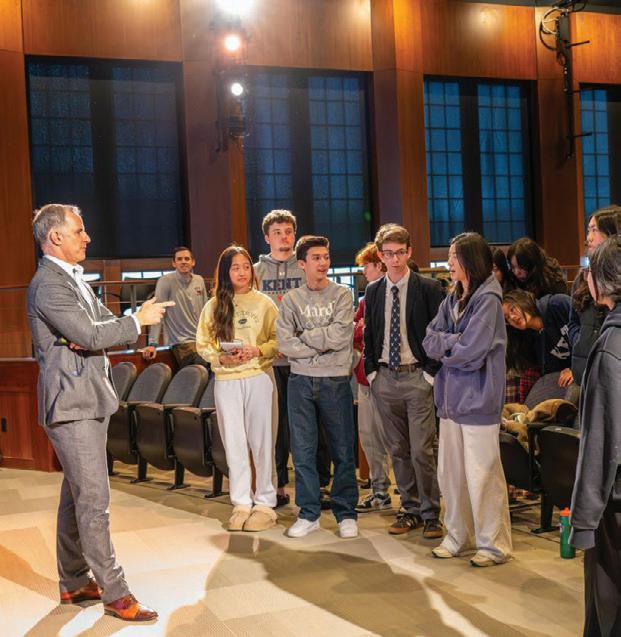
Tom Sanderson Returns to Campus for Lectures on Global Affairs
Kent School was honored to welcome back Tom Sanderson, global affairs expert and former director of the Transnational Threats Project at the Center for Strategic and International Studies (CSIS), a pair of compelling lectures focused on today’s most pressing international challenges.
Drawing on fieldwork conducted in over 75 countries, Mr. Sanderson spoke to the community about a range of global disruptive forces, including the ongoing Russia-Ukraine conflict, the rise of artificial intelligence, and the shifting landscape of international security and diplomacy. His lectures also offered students practical insights into careers in international relations and global policy.
Following each presentation, students participated in Q&A sessions, engaging Mr. Sanderson in thoughtful discussions that reflected both their intellectual curiosity and growing awareness of global dynamics. His visit provided a valuable opportunity for the Kent community to connect classroom learning with realworld experience.
Kent Welcomes NEASC Educators
Kent School had the privilege this spring of hosting the Visiting Committee from the New England Association of Schools and Colleges (NEASC), as part of the School’s accreditation cycle through the Commission on Independent Schools. Comprised of educators and administrators from peer institutions across New England—including The Governor’s Academy, Holderness School, Worcester Academy, Berkshire School, Belmont Hill School, Canterbury School, Kimball Union Academy, and New Hampton School—the committee spent several days on campus engaging with students, faculty, staff, and leadership, and closely observing all facets of school life.
NEASC accreditation is a voluntary, comprehensive process that promotes continuous school improvement and educational excellence. Through peer review and reflective self-study, member schools are evaluated on a broad range of standards, from leadership and mission alignment to teaching and learning practices, curriculum, and student support. NEASC accreditation affirms a school’s commitment to quality and accountability.
We are grateful to the Visiting Committee for their time, insight, and professionalism, and for the thoughtful feedback they shared.
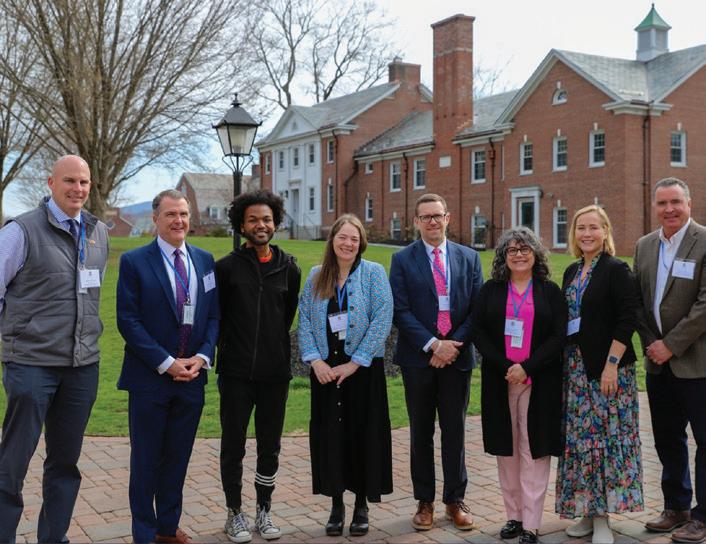
CAMPUS HIGHLIGHTS
CAMPUS HIGHLIGHTS
Students Bring the World to Kent in Multicultural Week Fair
Kent students organized Multicultural Week with a lively fair in the Dining Hall, where more than 200 attendees sampled food and experienced traditions from 14 countries. With support from faculty and staff, the event explored the diversity of the Kent community and offered a taste of cultures from around the world.

ARTS
Spring Break Tour Brings Kent Choir to Italy
The Kent School Chamber Choir spent spring break in Italy on a performance tour, giving concerts in Rome, Trevi, and Spoleto. The choir’s performances were met with enthusiastic audiences, and two concerts received encores.


Erin Reilly ’08 Reflects on Kent Roots and Entrepreneurial Growth
Kent School hosted Erin Reilly ’08 as the inaugural speaker of the Seto Family Inspiration Speaker Series. Reilly, who co-founded Pop! Promos with her Kent classmate Sterling Wilson ’08 and later served as its CEO, addressed students, faculty, and staff, sharing her experiences as an entrepreneur and reflecting on how her time at Kent shaped her mindset and career path.
Before her talk, Reilly joined members of the Investment Club for dinner, giving students a chance to ask questions and engage in conversation. Her presentation, centered on her journey from college startup founder to leading a nationally recognized merchandise company, offered practical advice and encouragement about pursuing meaningful work and staying grounded in values.
She spoke about how the many roles she took on at Kent helped shape her leadership skills and adaptability, and emphasized the importance of kindness, strong relationships, and the long-term benefits of treating people well. Another takeaway was the idea that early career risks often carry more potential than downside, and that starting something new doesn’t require knowing everything in advance.
Student organizers Roberto Jay ’25 and Jude Parker ’26 invited Reilly because her story felt inspiring and relevant to today’s Kent students. Reilly closed her talk by encouraging students to focus on doing one thing well and reminded them that there is room in any industry for thoughtful, dedicated people who bring their own approach.
The Seto Family Inspiration Speaker Series was created to connect Kent students with alumni whose stories can spark ideas and broaden perspectives. Reilly’s visit marked a strong and meaningful beginning to this new tradition.
CAMPUS HIGHLIGHTS
WELLNESS
A Day of Movement, Memory, and Meaning
In April, the Kent School community gathered for Move in Memory, a day honoring the lives of Michael Wright ’81, a beloved coach and faculty member, and Owen Trivell ’25, a well-loved student who bravely battled cancer. Rooted in remembrance and wellness, the event invited students, faculty, and staff to reflect, connect, and move in their memory.
The day began with a community gathering, where students and faculty shared heartfelt tributes to both individuals. The service was livestreamed so all members of the Kent family could take part.
Following the memorial, students participated in an hour of movement, choosing from more than 30 activities designed to promote wellness and reflection. Offerings ranged from hikes at Kent Falls and Macedonia Brook to yoga, ultimate frisbee, collage-making, trail running, and more, encouraging participants to try something new and connect with others across the community.
Organized by Wellness Director Annie Kearney, with student leaders Dana Burnett ’25 and Tripp Christman ’25, the event was designed to represent many aspects of wellness—physical, emotional, social, and spiritual—while encouraging new experiences and connections.
Whether hiking, dancing, creating, or simply walking the campus trails, the Kent community moved with purpose, honoring Owen and Coach Wright while coming together in support, connection, and care.

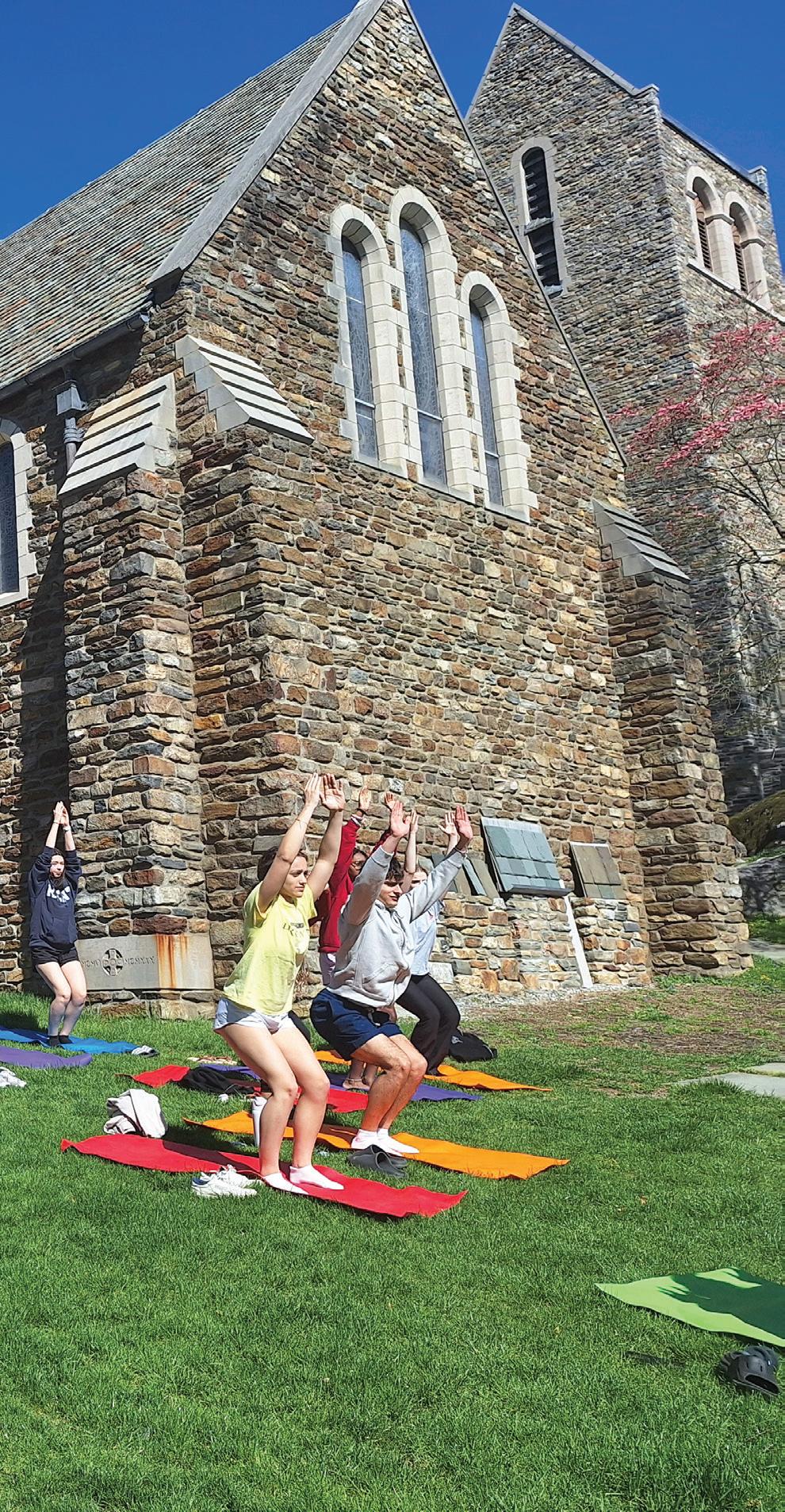
CAMPUS HIGHLIGHTS
Kent School Welcomes New Trustees
Kent School is pleased to announce the appointment of two new trustees to its Board. Their leadership, professional expertise, and commitment to education will help guide the School’s mission and strategic priorities.
James Clark P’27
James Clark serves as the Chief Investment Officer of of Acorn Advisory Capital. Previously, he was a partner, shareholder and co-chief investment officer at Pine River Capital Management LP, and earlier held senior roles at Goldman Sachs Asset Management, including head of risk and portfolio construction, co-head of U.S. fixed income and head of mortgage trading.
Clark earned a Bachelor of Arts in economics from Kenyon College and a Master of Business Administration in finance and statistics from the University of Chicago. He serves as a trustee of Kenyon College and is a former board member at Scenic Hudson. Clark and his wife, Sandra Guenther-Clark, live in New York City and are the parents of Jimmy ’27 and Anna.
Christopher J. Loughlin ’92 P’28
Chris Loughlin has served as CEO of BrainCheck since October 2024. He previously led Pixiu Investments as managing partner and served as CEO of Digital Pharmacist Inc. He also held several leadership roles at Travelzoo, including CEO, where he launched the company’s European business.
Loughlin earned a Bachelor of Science in technology management from the University of Staffordshire and Master of Business Administration degrees from the Haas School of Business at UC Berkeley and Columbia Business School. He is a former board chair of YPO Austin and current education chair of YPO Austin Gold. He attended Kent School as an English-speaking Union scholar and participated in football, wrestling, and club crew. He and his wife, Kathleen Irvin Loughlin, live in Austin, Texas, and are the parents of Vivion ’28 and Charlie.
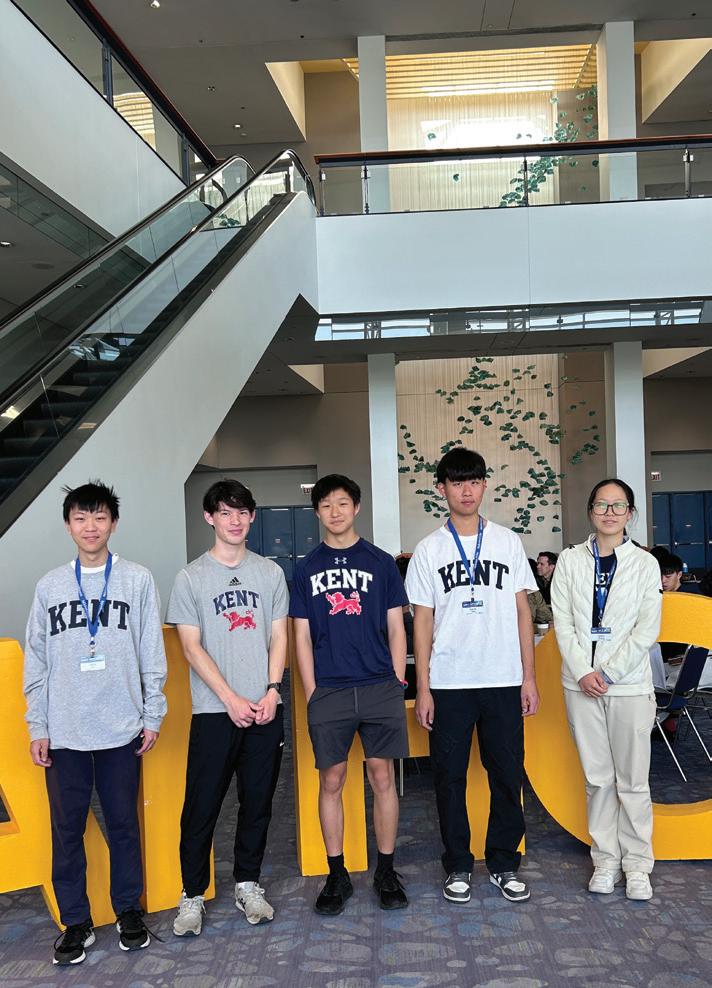
IN THE WORLD
Students Excel at MathCON Finals
Five Kent School students earned top honors at the 2025 MathCON Finals held in May at McCormick Place in Chicago. Representing Kent were Arthur Illidge ’25, Aaron Shin ’27, Selina Zhang ’28, Jerry Xu ’28, and William Xia ’28.
To qualify for the in-person finals, each placed in the top 5% nationwide on MathCON’s online exam, which draws more than 34,000 students from the U.S. and Canada. Only 628 advanced to the finals.
At the competition, participants completed a rigorous 100-minute test of 32 multiple-choice and constructedresponse questions. Illidge placed third overall among 12th graders, while Shin, Zhang, and Xia each earned Honorable Mention, ranking in the top 10 for their grade levels. Illidge also took fourth place in a Rubik’s Cube side competition.
The team’s combined results secured Kent the third place Outstanding School Award, which will be commemorated with a plaque.
The MathCON Finals, hosted by Concept Schools in partnership with Mathnasium and the National Council of Teachers of Mathematics, promote mathematical excellence while fostering collaboration among top students from across North America.
CAMPUS HIGHLIGHTS
Kent’s Flora Flourishes Under Expert Care
Kent’s master gardener, TeddieAnn Miner, has been hard at work bringing the campus to life this spring. Beginning in February, she and science teacher Joel Varley started seeding in the greenhouse atop Dickinson. Since then, they have nurtured the plants and carefully transplanted them throughout the grounds, creating vibrant displays that brighten the campus.

ACADEMICS
Academic Excellence
Recognized: Cum Laude Inductees and Honorees
Faculty members of the Cum Laude Society gathered at the Cumming House in May to celebrate the 19 newest student inductees, recognized for their exceptional academic achievements.
Special congratulations to two faculty honorees, Tom Hunt and Kevin Saxton.

WELLNESS
EmpowerHER Day Brings Mentorship and Community to Kent
Kent School’s Women’s Wellness Club hosted the inaugural EmpowerHER Day, designed to inspire and uplift the next generation of girls. Each young participant was paired with a “big sister,” and Kent students led activity stations to share their passions and talents, creating a day of mentorship, learning, and community.
Congratulations to:
Brooke Cesarski ’25
Oliver Chan ’25
Sophia Chen ’25
Aoife Collins ’25
Clara Cumming ’25
Marcus Decorato ’25
Brioni Earle ’25
Roberto Jay ’25
Walter Kaufman ’25
Syna Kikanamada ’25
Phillip McCoy ’25
Kamsiyochukwu Nwotite ’25
Jiratchya Prapakamol ’25
Hudson Saunders ’25
Kaitlyn Shen ’25
Kendall Shima ’25
Ying-Ying Wu ’25
Zhidong Zhang ’25
Xiaowen Zhou ’25
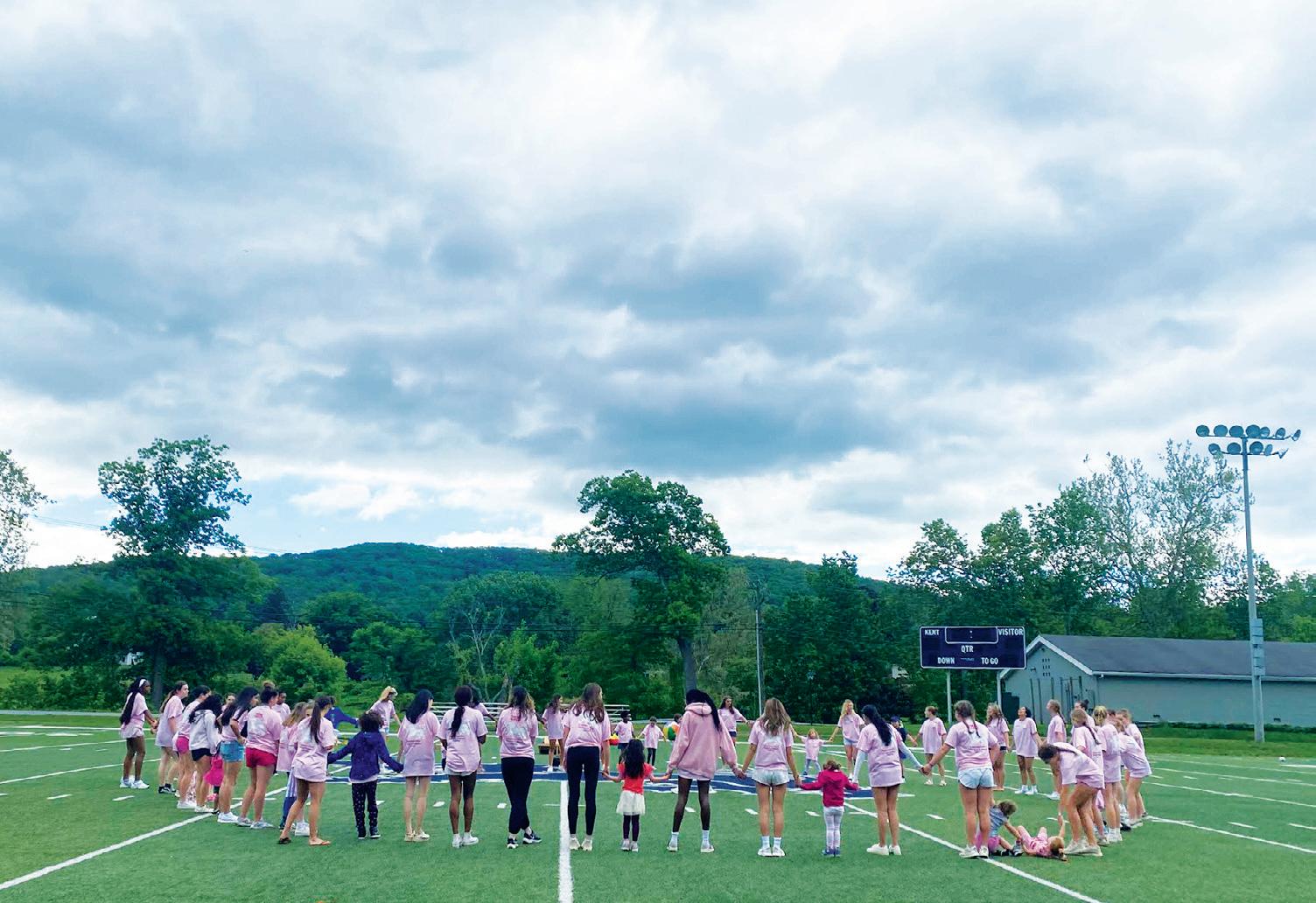
A Season of Creativity
Spring at Kent brought a vibrant array of artistic performances and creative work across campus.
Kent musicians delivered a dynamic performance at the 2025 Spring Concert in Mattison Auditorium, which also included the induction of students into the Kent Music Honor Society and recognition of the CMEA Northern Regional Award recipients.
The Kent School production of Mean Girls: The Musical transformed Mattison Auditorium into North Shore High, with performances and behind-the-scenes efforts filling the space with energy.
The Dance Ensemble presented the Spring Dance Recital, featuring styles from hip-hop to classical ballet.
The latest issue of The Cauldron, Kent’s student-run magazine, highlights original art and writing by students, offering another glimpse into the creative work happening across campus.



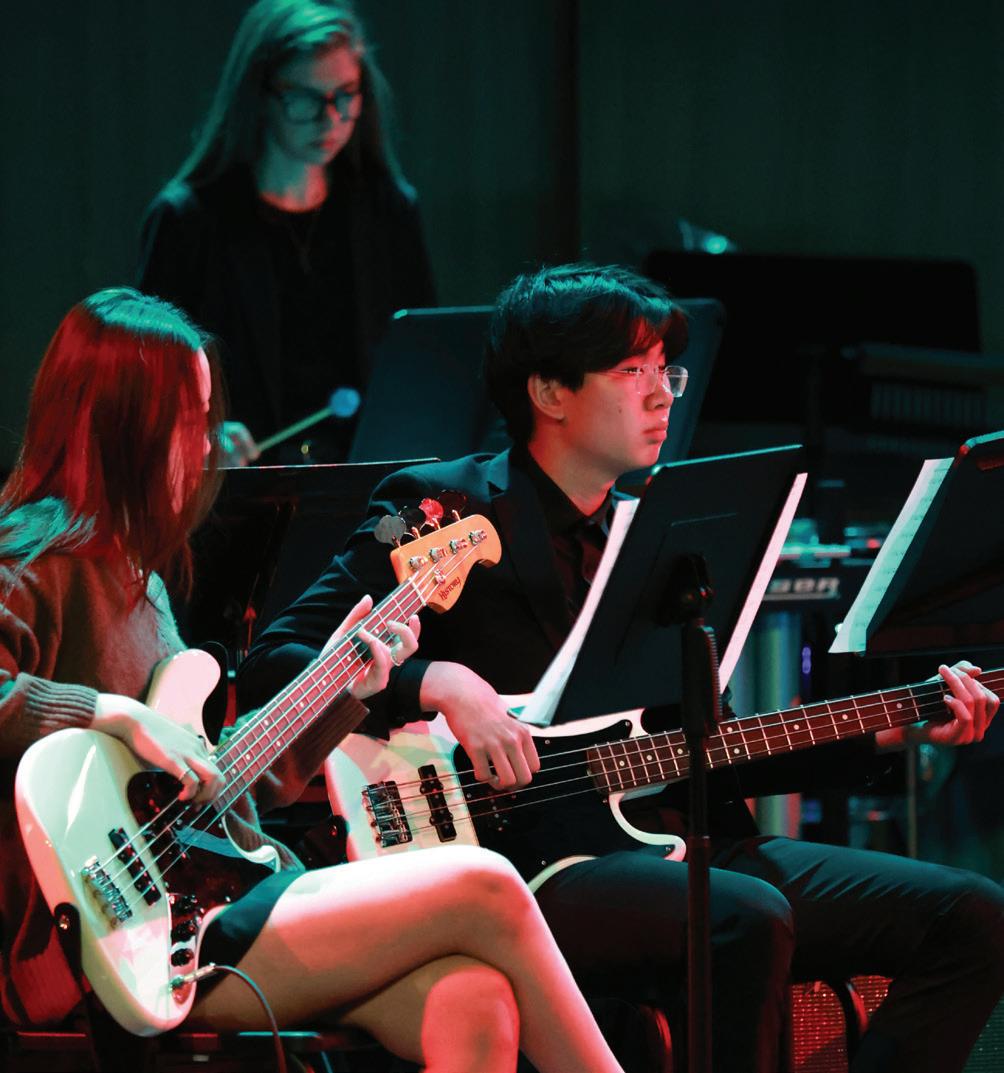
Scan the QR code to view the full issue of The Cauldron.




Season Recap: Kent Athletics Spring 2025
BASEBALL

The team embodied hard work, character, and camaraderie throughout the season. With nine Six Formers graduating, they leave behind a legacy of leadership and dedication that will inspire future players.
SOFTBALL

The girls varsity softball team wrapped up a standout spring season filled with impressive achievements, including no-hitters, home runs, and regional and national honors. Pitcher Nora Lennon ’28 surpassed 100 strikeouts in just 10 games, with a season-high 17 against Millbrook, and earned All-NEPSAC Honors. Izzy Bowler ’25 was recognized as an NFCA All-America Scholar-Athlete for her academic excellence and on-field contributions as well as All-NEPSAC Honorable Mention. “Our team culture was incredible, and it has set us up for future success, says Coach Sean Lennon.

In his first season, Coach Rich Mok led the boys varsity lacrosse team through a competitive and promising campaign. With strong leadership from six dedicated Six Formers, the team held their own against tough competition and laid a solid foundation for the future. Rising senior Trey Lalonde ’26 earned All-NEPSAC Honorable.

The boys varsity tennis team, led by Coach Tom Hunt, closed out the season on a high note with a win over Trinity-Pawling on May 17. This victory marked the end of Coach Hunt’s 13-season tenure at Kent, as he retired this May.
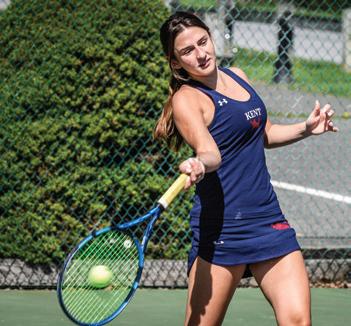
The girls varsity tennis team capped off its spring season with a dominant sweep over Ethel Walker. Powered by the leadership of seven seniors, the team showcased skill, determination, and depth throughout the season.
GIRLS LACROSSE

The girls varsity lacrosse team kicked off its season with a training trip to Arizona, where they worked with Trilogy Lacrosse. Competing in the always-tough Founders League, the team notched key wins over Westminster and Miss Porter’s School. Anika Berry ’27 reached an impressive milestone with her 100th career point late in the season. Hadley Lineberger ’25 earned All-NEPSAC honors for her standout performance in goal, while Kate McKiernan ’26 received Honorable Mention recognition for her strong play throughout the season.
BOYS LACROSSE
BOYS TENNIS
GIRLS TENNIS
BOYS GOLF

The boys varsity golf team recorded multiple wins this past season and hosted its annual Western New England Invitational at Bulls Bridge Golf Club. The JV team also had a strong showing, earning six victories. The program bids farewell to 10 graduating Six Formers.
GIRLS GOLF
The girls golf team delivered a stellar, undefeated season, showcasing consistency and skill from start to finish. With no graduating seniors, the team is poised for continued success and enters next season with experience, momentum, and a bright future ahead.
EQUESTRIAN
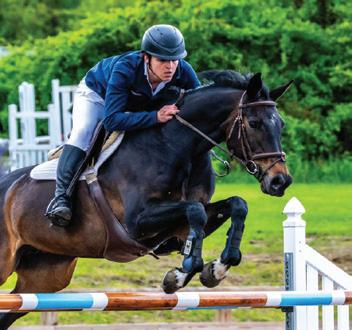
KSET hosted its annual Spring Classic in May, highlighting a weekend of strong performances. Notable moments included Vidal Lagüera ’25 and his mare, Havana, winning the 1.20m Jumper
Classic, and Berlin Hill ’26 and her horse, Louie, capturing the Hunter Derby Perpetual Trophy. Congratulations to the team’s three graduating seniors for their contributions to the program.
GIRLS ROWING

The girls rowing team wrapped up their season at NEIRAs with a strong showing, placing sixth and fifth in the Grand Finals, along with seventh- and eighth-place finishes. The team was anchored by 10 Sixth Formers whose leadership and experience played a key role throughout the season.
BOYS ROWING

The boys rowing team earned multiple wins and placed at nearly every regatta this spring. They capped off a strong season with third-, second-, and sixth-place finishes in their Grand Final races at NEIRAs. The team was led by eight seniors who played a key role in this season’s success.
Jason Coulombe Appointed Interim Athletic Director for 2025–2026 Academic Year
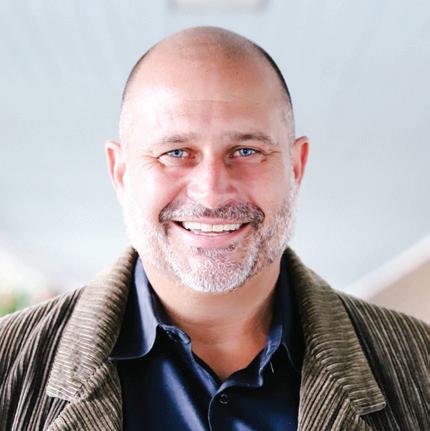
Jason Coulombe, a Kent faculty member for 18 years, brings more than 25 years of experience in independent school education as a teacher, coach, and mentor. “I’m excited to take on this important responsibility and help move our athletics program forward,” he says. “Athletics offers us a powerful opportunity to shape a positive, characterdriven culture while showcasing the strength of our community.”
At Kent, Coulombe has supported student leadership through the Kent Leadership Initiative and the Kent Athletics Leadership Council, which unites varsity captains for ongoing development. He also coached the boys’ varsity basketball team from 2008 to 2018, leading the team to a NEPSAC championship and the most wins in the league’s large-school division over that span. Since 2020, he has headed the girls’ varsity basketball program, guiding the team to consecutive NEPSAC Tournament appearances, including a finals run in 2024. As interim athletic director, Coulombe will continue coaching and teaching while strengthening Kent Athletics through character, accountability, competitiveness, and joy. “We have a strong foundation,” he says. “I’m confident in our ability to accomplish great things together.”
CAMPUS HIGHLIGHTS
Traditions and Recognitions
May at Kent was busy with the traditions that mark the close of the school year.
The Ring Ceremony offered a meaningful moment for Fifth Formers stepping into their final year, a celebration of friendship and continuity that has long been part of the Kent experience.
Members of the Class of 2026 made its way up to Numeral Rock, brushes in hand, to leave its mark. With fresh coats of purple and gold and a bold “26,” Rock Day once again brought energy, color, and plenty of school spirit to the hillside.
The season came to a close with Tapping, as cheers rang out for the newly announced Senior Council. The evening wrapped up on Club Field, where ice cream and a bonfire carried the celebration into the night.
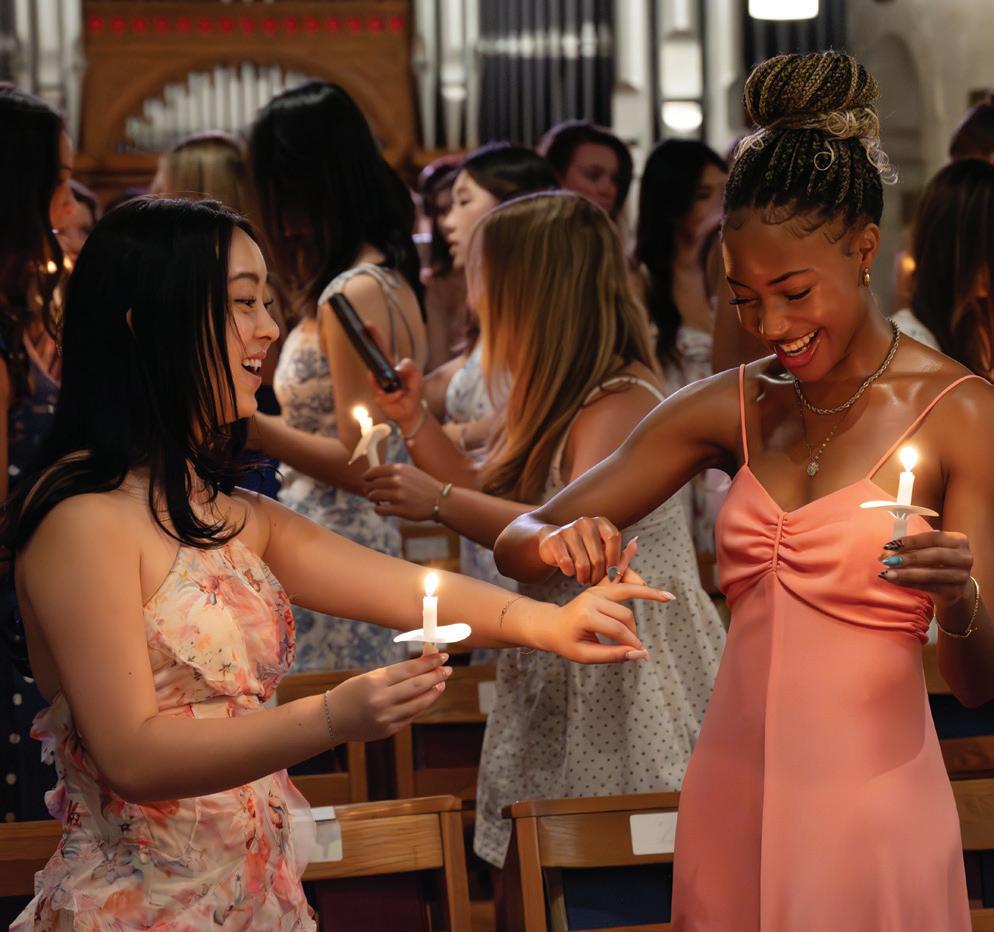

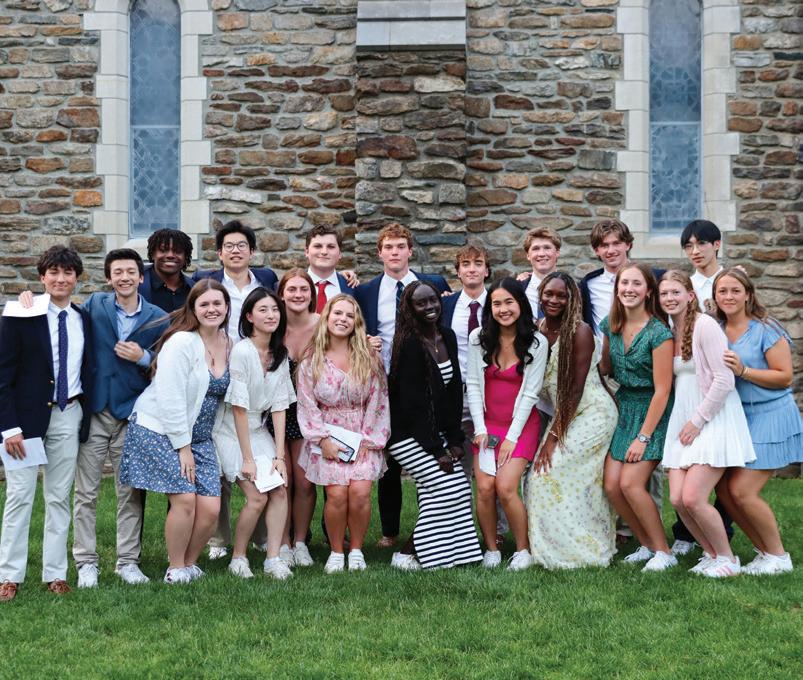
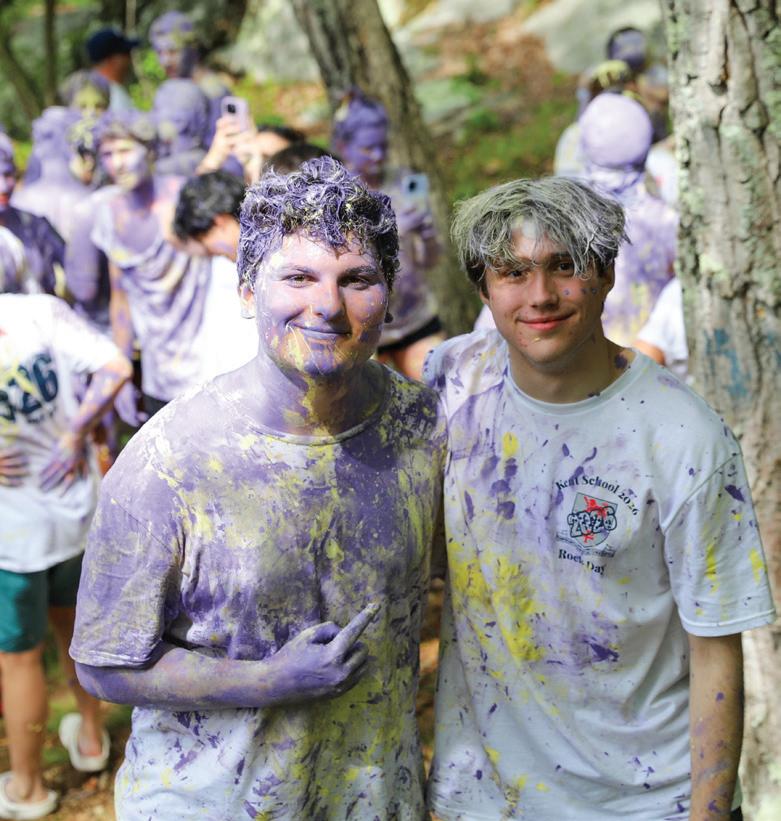
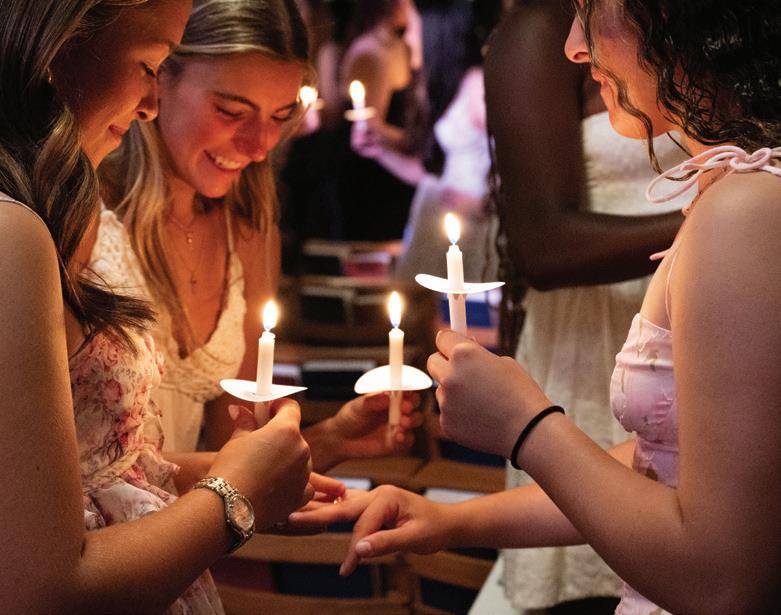


Congratulations to the 2025-2026 Senior Council Members!
SENIOR PREFECT
Eli Booth
Kate McKiernan
BLUE KEY HEAD
Charles Paquin
Annika Hohn
DORM PREFECT
Jude Parker
Amy Hwang
DORM PREFECT
Jack Broderick
Agar Malek
DORM PREFECT
Harry Wan
Angel Lin
DORM PREFECT
Jojo Njoh Mbengue
Zizi Nwotite
DORM PREFECT
Arthur Wang
Margot Kukulski
SACRISTAN
Charlie Cosgriff
Maggie Barth
STUDENT LIFE STEWARD
Owen Gawel
Mackenzie Clifford
VERGER
Jaime Avancena
Casey Brodie
SIXTH-FORM REPRESENTATIVE
Xavier Sanchez
Alexandra Erdheim

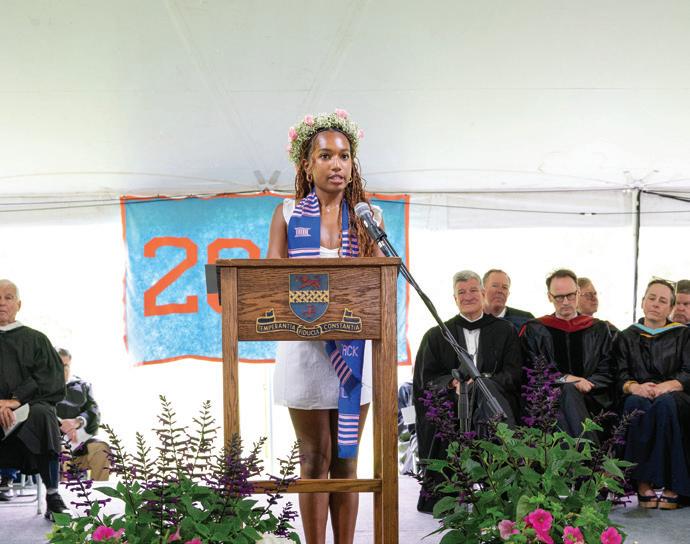






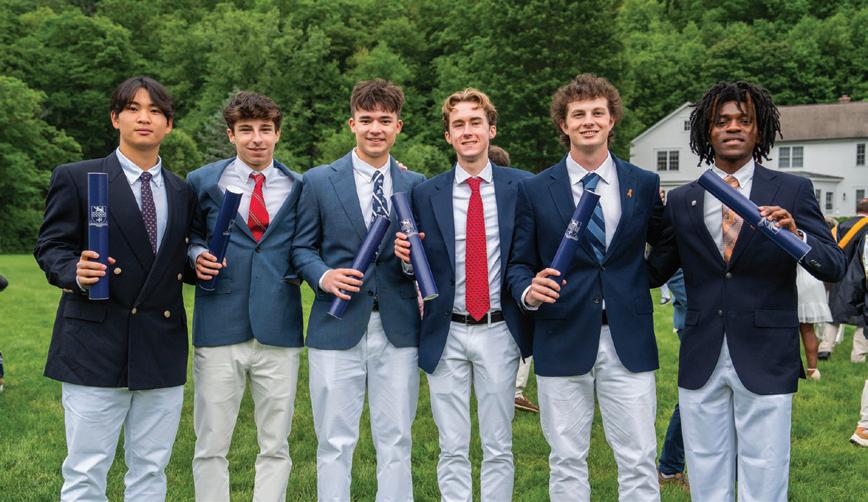
GRADUATION 2025
Kent School Celebrates the Class of 2025 Between
On Sunday, June 1, the Kent School community gathered to celebrate the Class of 2025. Families, friends, faculty, and staff came together to honor the graduates and reflect on the values that shaped their time at Kent.
Senior Prefects Tripp Christman and Dana Burnett spoke on behalf of their classmates, offering reflections that captured both the challenges and triumphs of their years together. Christman spoke about the strength that comes from community, the importance of asking for help, and the need to care for oneself even in uncertain times. Burnett honored the women who inspired her during her Kent journey, recognizing their quiet confidence and daily acts of kindness. She urged her classmates to carry those lessons forward, encouraging them to lead with both ambition and compassion.
Their words set the tone for the day, reminding all in attendance that the Class of 2025 leaves Kent with not only academic accomplishments but also with a deeper understanding of what it means to support and inspire one another.
The commencement address was delivered by John Palfrey, president of the John D. and Catherine T. MacArthur Foundation. Drawing on his career in education, law, and philanthropy, Palfrey urged graduates to see this moment not only as an ending but as a beginning. He pointed to Kent’s values—Simplicity of Life, Directness of Purpose, and Self-Reliance—as touchstones that can guide them through life’s challenges.
Palfrey reminded the graduates that each their family’s story and now adds Kent to that legacy. Quoting his great-great-grandfather, President Theodore Roosevelt, he encouraged the Class of 2025 to be “the person in the arena”—to step forward, take risks, and make a difference.
“Each of you has created a new family legacy by graduating from Kent,” Palfrey said. “Yes, the future is uncertain, but you leave here ready to shape the world, not from the sidelines, but by being fully in it.”
Hills and River Shore
Kent Squared: Where Talent Meets Opportunity
By Oliver Bustos and Nick Favaloro
What happens when you give talented young minds the space to think deeply and dream boldly? At Kent, we are witnessing the answer unfold each summer through a program called Kent Squared, a transformative partnership with Squared, a national nonprofit that expands opportunities for talented students.
Kent Squared is built on the simple idea that the tools of a Kent School education—rigorous inquiry, collaborative discourse, and a commitment to excellence—can be extended to first-generation, low-income students from public schools across the country. Over three summers, Kent Squared students immerse themselves in a five-week program that focuses on math, engineering, writing, and college counseling.
At Kent Squared, students are fully immersed in campus life. Students live in Case Dorm and Hoerle Hall, eat in the dining hall, and spend their afternoons rowing on the Housatonic or practicing tennis in the Bourke Racquet Center. They wrestle with calculus problems and craft their personal narratives in writing class. Throughout, they are learning how to think with clarity, compassion, and curiosity. Students routinely describe the community as “a family.” The result is a genuine slice of the Kent experience, one that inspires
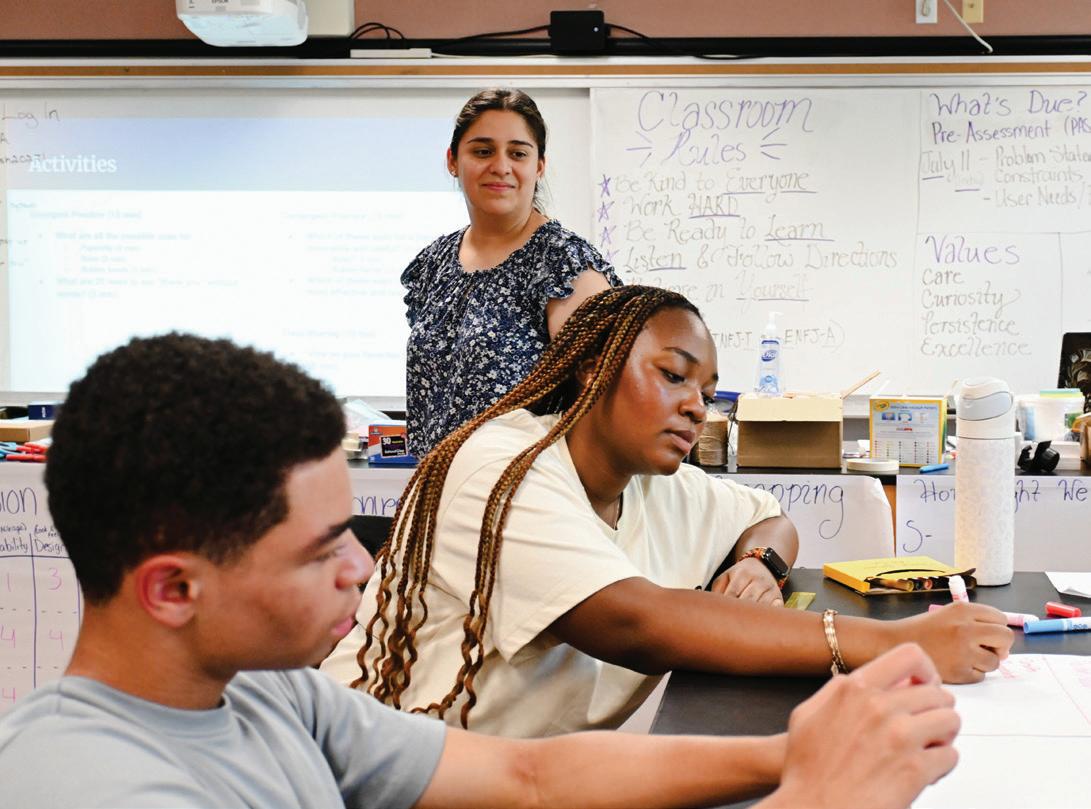
students to see themselves as members of the community here at Kent School. Squared identified and selected Kent School as a partner after a competitive search process that considered over 50 different independent boarding schools across the country. Nick Favaloro, CEO of Squared, explains why Kent School was chosen: “We found immediate and deep alignment with Kent School leadership. From the dining hall to the operations and facilities teams to the Kent School faculty … we are so grateful that we have encountered nothing but collaboration and open arms. Plus, it certainly doesn’t hurt to live in such a beautiful summer-camp-esque setting along the Housatonic.”
For the Kent School, mission-aligned summer programming like Kent Squared offers multiple benefits above and beyond the students’ experience. It helps keep the lights on in the summer and supports services like dining to run smoothly year-round. It also offers meaningful summer employment for Kent School teachers who are interested in participating. Alumni, faculty, and friends of Kent are already helping Kent Squared thrive through mentoring, summer visits, and program support.
Ryan Foote, a longtime English teacher, is one of a number of Kent School faculty members who have taught at Kent Squared over the past two summers. When asked about Squared, Foote shares, “I sing this program’s praises. I love teaching students who enjoy learning for learning’s sake. My Kent Squared students have been so kind and express so much gratitude. I find myself rooting for all of them by the end of the summer. Can life get any better teaching in a community like this?”
Squared has a long history of success. The first program of its kind was established in 1977 at Phillips Academy in Andover, and 30 years later the flagship Squared affiliate program, (HS)², launched at the Colorado Rocky Mountain School in Carbondale, Colorado. Kent School Assistant Head of School, CFO & COO, Jeff Cataldo, visited the (HS)² program in Colorado in the summer of 2023 and immediately recognized that this program could thrive at Kent. When asked why bring Squared to Kent, Cataldo explains, “I am not sure I can think of a better way to use the Kent School campus during the summer months. Helping high-achieving students who crave more support to
SUMMER PARTNERSHIP
The Squared Network

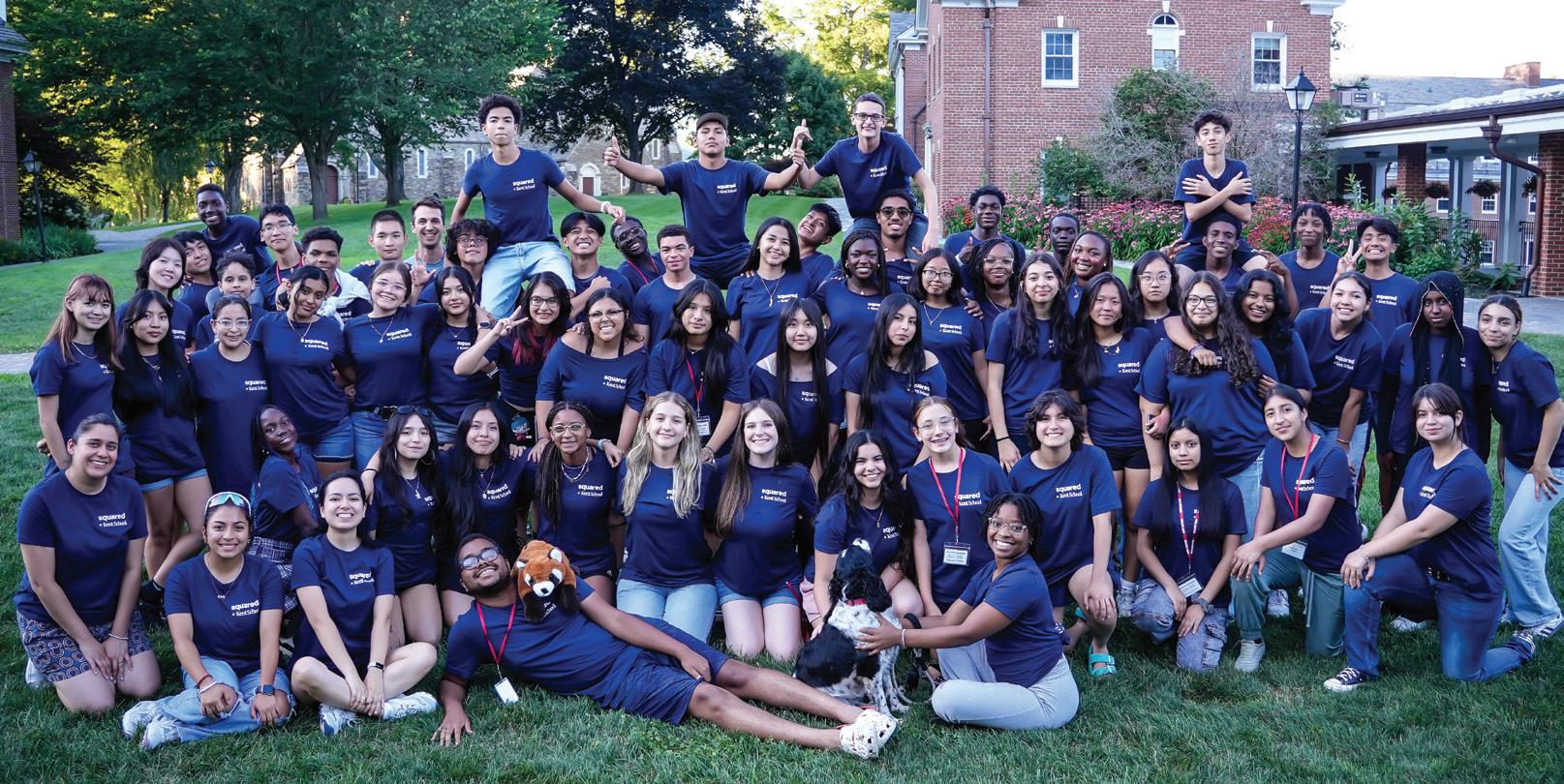
“Helping high-achieving students who crave more support to fully recognize their learning and overall development goals is what Kent School does.”
JEFF CATALDO, ASSISTANT HEAD OF SCHOOL, CFO & COO
fully recognize their learning and overall development goals is what Kent School does.”
The (HS)² program, Squared’s flagship affiliate, has a nearly 20-year record of success, with 88% of alumni graduating from college: far exceeding the national average for low-income, first-generation students. Many go on to high-growth STEM careers, and nearly one-third return as faculty, inspiring the next generation as engineers, scientists, educators, and entrepreneurs.
One such leader is Marisol Sanchez, now executive director of Kent Squared. Sanchez graduated from the (HS)² program in Colorado before attending Worcester Polytechnic Institute and pursuing a career in design engineering at SharkNinja. As director, Sanchez leads
student recruitment efforts, selecting the program's students from regions across the country, including West Texas, Denver, New York City, New Haven, Norwalk, Bridgeport, and Waterbury. Next year, the program will continue to grow to serve 90 students in total. Kent School is leading the way in the independent school space. This upcoming summer, the Middlesex School in Concord, Massachusetts, will follow lead and open their own Middlesex Squared program in partnership with Squared. These two new programs are important steps in Squared’s mission to work in partnership with independent schools to expand opportunities for talented first generation low-income students across the country.
And at the heart of all of it lies a strong student experience. When reflecting on their summer, one student from New Haven, Connecticut, shares: “Kent Squared is a loving community where you create a bond with everyone. It’s an opportunity to meet amazing people and build another family. [The program] has prepared me for school and given me an opportunity to achieve in STEM fields.”
There are many ways to get involved and help contribute to the launch of this exciting chapter for Kent School. If you are interested in learning more about Kent Squared or supporting the program, please contact Jeff Cataldo at cataldoj@kent-school.edu. And please come visit the program in action next summer!
RETIREMENTS
Celebrating Our 2025 Retirees
Kent School celebrates the remarkable careers of four longtime members of our community. Their decades of dedication, leadership, and service have left a lasting impact on students, colleagues, and the broader School. We honor Tom Hunt, Karen Moreno, Denny Mantegani, and Todd Marble for their contributions and wish them a well-deserved retirement.

KAREN MOREANO
Karen Moreno joined the Kent faculty in 1997 and has been a valued member of the English Department and the broader School community for 26 years.
She began her teaching career at Kent as an instructor in English as a Second Language and later taught English 1 along with a range of Sixth-Form electives, including Slave Narratives. Outside the classroom, she served for many years as faculty advisor to the yearbook and also assisted with timing several sports. In 2007, she was awarded the Clifton K. Loomis Teaching Chair in English.
Moreno is known for her kindness, patience, and commitment to helping students discover their own voices. Through creative assignments and thoughtful guidance, she has inspired generations of Kent students to grow both academically and personally.
TOM HUNT
Tom Hunt joined the Kent faculty in 2003 and retires this year after 22 years of teaching English.
During his time in the English Department, Hunt taught a wide range of courses, including Honors English 2, The Art of the Personal Essay, and Russian Literature. He also served as head varsity boys tennis coach for many years and coached girls squash and boys soccer. In 2014, he was awarded the David C. Clapp ’56 Teaching Chair in English.
Hunt is known for setting high expectations while modeling dedication and hard work for his students. He was always available to provide feedback and support outside the classroom, helping generations of Kent students develop their skills and confidence. His impact as a teacher will be remembered by many graduates who credit him with helping them grow as writers and thinkers.
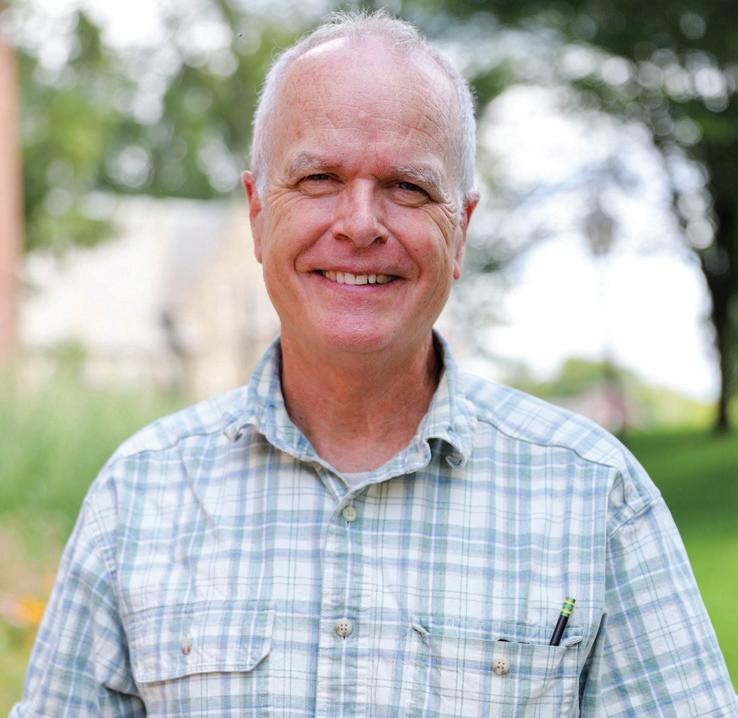
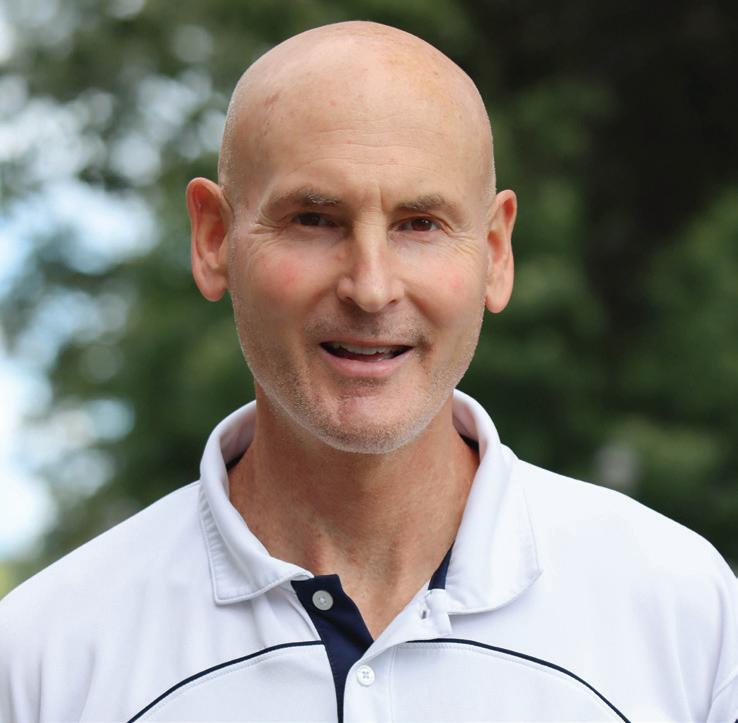
TODD MARBLE
Todd Marble has served Kent for over 30 years, leaving a lasting mark on the School in a variety of roles. He has coached football, served as an advisor and athletic director, and guided alumni and parents as director of planned giving. Throughout his career, Marble’s dedication, work ethic, and commitment to the Kent community have been unwavering, evident in his record of never taking a sick day.
His leadership, guidance, and support have contributed to the growth and success of the School while shaping the experiences of countless students, families, and colleagues. Known for his professionalism and steady presence, Marble has had a profound and lasting impact on the Kent community.
DENNY MANTEGANI
Since joining Kent in 1983, Denny Mantegani has contributed to the School in many roles, including admissions officer, director of financial aid, English teacher, dorm head, director of development, director of donor relations, and rowing coach. She is also an honorary member of the Classes of ’58, ’62, ’67, and ’72.
Throughout her career, Mantegani has shown remarkable dedication and a focus on helping others, supporting generations of students, families, and colleagues with her steady presence and deep knowledge of the School. She is respected not only for her professionalism, but also for her warmth, humor, and unwavering commitment to Kent’s mission.
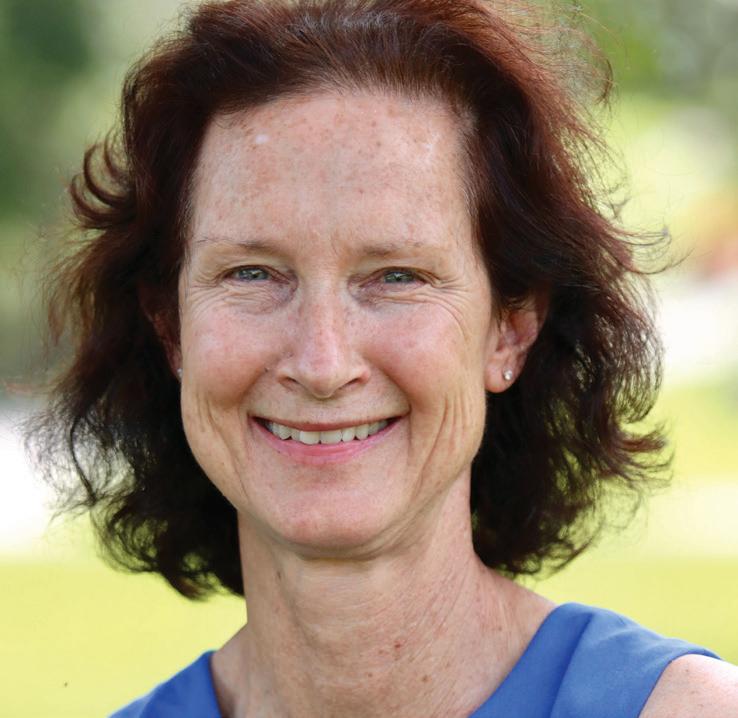
Be Like
After basketball practices in the winter, Assistant Boys Basketball Coach Michael Wright ’81 would voluntarily stay late to throw batting practice for the baseball team. Each morning, as he passed by his colleague Shaquille Brown-Butler’s office in Admissions, he’d knock on her door and hold out his hand for a fist bump. She might remind him, half-joking and half-serious, that he was still committed to teaching students the Electric Slide for the upcoming Black History Month celebration. Every day, he took time to connect with students and faculty along the walkway, offering each person his full attention and making them feel like the most important person in the world.
Wright was a fixture at Kent, and when he passed away unexpectedly on February 17 at Sharon Hospital, he left a void on campus. As news of his passing began to spread, so did the outpouring of grief. Wright, 63, was the Associate Director of Admissions, Assistant Football Coach, Assistant Boys Varsity Basketball Coach, Head Varsity Baseball Coach, advisor, alum, and friend to generations of Kent families. To many, he was the soul of Kent.
“Michael touched the lives of so many, offering his warmth, kindness, and unwavering support to prospective families, students, athletes, and colleagues alike,” said Head of School Michael G. Hirschfeld. “He had the unique ability to make everyone feel valued.”
Tim McCarthy, Boys Basketball Head Coach, Assistant Football Coach, and English Faculty, got to know Wright on the sidelines. Wright reflected a rare kind of grace—physical, emotional, and moral—and McCarthy was deeply moved by both his coaching style and his approach to life. “Mike was graceful in the way he acted and the way he moved, and in how he built connections around campus,” McCarthy said. “He was the most genuine person I’ve ever met. He wasn’t fake in any way. He would literally give you the shirt off his back.”
Each person who interacted with Wright has a story about how his wisdom and guidance have impacted

Mike
Remembering Michael A. Wright ’81
By Megan Tady

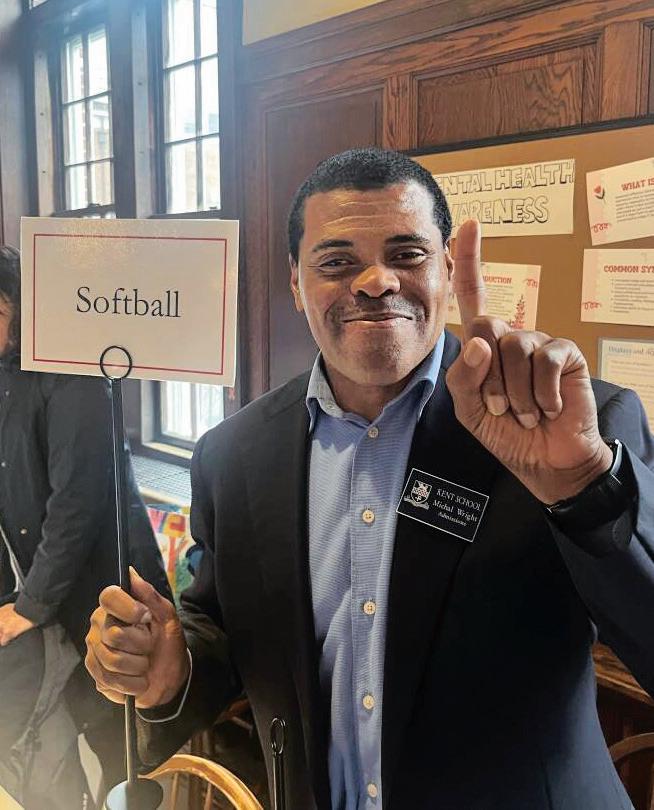

their own lives. Brown-Butler recalled interviewing at Kent in 2023. On her way out to the parking lot, she met Wright for the first time, and they ended up talking for two hours. “As a Black woman applying to work at Kent, that conversation meant a lot to me,” she said. “I knew that if I got the job, I’d have a friend in the office, just based on how authentic, real, and valuable that moment was. Mike felt like a warm father figure, someone who was willing to be vulnerable and authentic, to ask about my life and share about his own.”
Indeed, Wright’s upbringing hadn’t been easy. He was born on July 4, 1961, in Aiken, South Carolina, to the late Hayward Mosely and Victoria Wright of Warrenville, South Carolina, but he was raised by his great-grandparents and extended family members.
He arrived at Kent as a young man seeking stability and direction, and he
found a lifelong home. In a tribute speech about Wright, McCarthy said, “He had been bouncing around from college football team to college football team, living with an assistant coach, which is not exactly a great lifestyle for a young kid. And then he found Kent, and it really changed his life. He came to understand, I think, what home feels like. He felt an immediate connection with the people here, especially his coaches.”
Peter W. Bragdon, Director of Admissions at Kent from 1970 to 1983, recalled meeting Wright. “His uncle told me that he was traveling too much for West Point football to care for him, so we at Kent School adopted Mike. He grew through five years of perseverance, always offering a smile to the world, no matter what challenges were burdening him. No person offered more constant love than Michael; just greeting him was a joy. He is the most beautiful person who ever became a member of the Kent School family.”
Wright excelled athletically at Kent on the varsity football, basketball, and baseball teams, and his talent and sportsmanship earned him a place in the inaugural class of the Kent School Athletic Hall of Fame in 2001. At Commencement, he was honored with the Columbia Cup. After Kent, he earned a bachelor’s degree from St. Lawrence University and went on to teach and coach at other private schools before returning to Kent in 2021. He and his wife, Sherry, lived in North Dorm, and he had five children.
To those who worked alongside him, Wright was a model of humility and consistency. “Michael was a beloved member of our Admissions team and a one-in-a-million friend,” said Amy Ober, Kent’s Director of Admissions. “He had a heart of gold and would give anything he had to others. He was the most humble, modest, and selfless person one could ever have the privilege to meet. He truly embodied Kent’s motto—Simplicity of Life, Directness of Purpose, and Self-Reliance— and lived it every day.”
This page, top: Michael Wright at a Kent Revisit Day
This page, bottom: Wright and Denise Howard from the Admissions Office at a Kent event
Opposite page, top: Wright at his 1981 graduation Opposite page, right: Coach Wright on the baseball field
Wright brought the same heart to the athletic fields and courts of Kent. “As a coach, everything just came so naturally to him,” McCarthy said. “He wasn’t a loud coach. He just brought a ton of energy and had great relationships with each of the players he coached. It was all in this quiet, subtle way.”
In his role as a student advisor, Wright formed deep, enduring relationships with students. Morgan Johnson ’25, who wrote a song about Wright after his passing, put it best: “Mr. Wright was not only an amazing advisor and mentor, but the most selfless and kindhearted person I’ve ever met. He had the ability to lighten any room he walked into, and he left that light with his amazing family. His love will forever be remembered by the lives he’s touched, especially mine.”
Brown-Butler was impressed by the way Wright interacted with students. “The way he talked to kids had this balance—he held very high standards, and he was going to hold you to them,” she said. “But he also understood that you don’t show up on day one already meeting those expectations. So he’d hold your hand and lift you up to where he expected you to be.”
On April 30, the Kent School community came together for Move in Memory, a day dedicated to honoring Wright’s life, as well as Owen Trivell ’25, a well-loved student who passed away after a courageous battle with cancer. Rooted in remembrance and wellness, the event invited students, faculty, and staff to reflect, connect, and move.
Beyond that event, Wright’s legacy endures every time people look to his memory as a north star for how to live with purpose and humility. “I think what the students and the rest of the community will take from him, what it means to be like Mike and to do things the way Mike would’ve done them, centers on assuming the best in people,” Brown-Butler said. “He embodied what being at Kent is all about. He led with goodness.”
Celebration of Life
After Michael Wright’s passing, Kent invited community members to share photos, memories, and special stories on the digital platform KudoBoard to help celebrate his life. Dozens of students, players, former classmates, parents, and colleagues shared their grief over the loss of such an influential person while documenting the myriad reasons he was so beloved. Scan the QR code to view the full collection of comments and tributes.




ENGINEERING WITH PURPOSE
Preparing students to lead, create, and solve challenges in the world beyond Kent
By Megan Tady
Over the past four years, the Wentz Engineering Program at Kent has evolved and flourished, embodying the critical and creative thinking that aligns with the school’s mission. Engineering Program Director Carlos Bezerra says the department has been gradually working to reposition engineering within the academic structure as a core discipline that requires study, theoretical understanding, and application. “We emphasize that engineering involves both making things and understanding how and why things work,” Bezerra says. “This helps students connect what they’re learning to the real-world impact.”
Dr. Ben Nadire, Kent’s first engineering program director, led the
efforts to introduce engineering to Kent, which was titled “pre-engineering.”
Initially, the program was conceived as an introduction for students exploring engineering as a potential college major. It offered STEM electives and occasional lectures.
Hands-on learning took center stage first under former faculty member Ryan Harris and later under Bezerra’s leadership. The program now boasts a robust curriculum, a competitive solar car team, a range of innovative capstone projects, and fascinating field trips. Students can also pursue an Advanced Studies Diploma in Engineering.
Like the engineering process itself, Bezerra says this program’s development started with small-scale
Opposite page, top: Holy Solar’s car in action
Opposite page, bottom: Jolie Malo`27 making adjustments in the cockpit before entering the track
efforts and tangible outcomes. And much of it has been student-driven. “It’s the students’ involvement and commitment that is leading the way and helping us get more recognition at Kent,” he says.
Kevin MacNeil, academic dean and math faculty, says the program meets a rising demand in education: preparing students to think critically and creatively. “Engineering students are doing real work and solving real problems, and that’s what colleges want to see,” MacNeil says. “They’re less focused on whether students arrive with an encyclopedia of knowledge, and more interested in what students can do, how they think. In that sense, the engineering program fits perfectly into the direction education is moving.”
The Holy Solars: Building More Than A Car
The Solar Car Challenge is the cornerstone of Kent’s engineering program. Founded in 1993, the national STEM competition tasks students with designing and building solar-powered cars over a 14-month period, culminating in a race against other high school teams at Texas Motor Speedway in Fort Worth. Kent’s team, the Holy Solars, first competed in 2021 and won first place in the Classic Division. “The project has become deeply meaningful because of its complexity and authenticity,” Bezerra says. “It is, arguably, the most ambitious engineering challenge we can offer at the high school level. It reflects the multifaceted nature of engineering— design, planning, teamwork, problemsolving, creativity, communication, and innovation—all embodied in a single, large-scale project.”
This July, the team—now 12 students strong, up from four in its inaugural year—competed in the Advanced Division. Entering this division meant designing a high-aerodynamic body using carbon fiber, a material more commonly found in college-level
engineering builds. “This year we had to make things we’d never made before,” Bezerra says. “I handed the students a book and encouraged them to begin researching other sources. And then I watched them figure it out, and they began teaching me.”
While the learning curve was steep, Bezerra says the “experiential component of engineering is a great teacher, and the problems teach us how to solve them.” He adds a favorite quote often attributed to philosopher Immanuel Kant: “Experience without theory is blind, but theory without experience is mere intellectual play.”
The challenge also pushed the team
to adopt new digital tools, including Computational Fluid Dynamics (CFD) software from the Autodesk suite, which allowed students to simulate wind tunnel effects. After designing a 3D model, they ran aerodynamic simulations to optimize performance.
Jolie Malo ’26, a Holy Solars team member, says the experience taught technical and mechanical skills, along with confidence, teamwork, and resilience. When shipping delays jeopardized their build, the team improvised workarounds—even during scrutineering on the final day of inspection. “Without resilience, our team would have never made it through

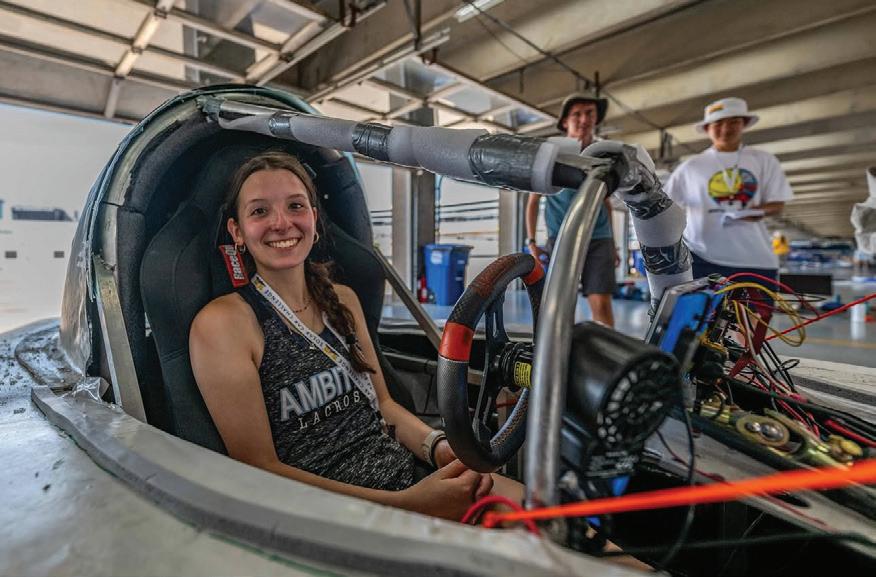


half the challenges we faced,” Malo says. “The Solar Car Challenge transforms theoretical learning into real-world experience because when our car hits the track, it needs to work.”
In Fort Worth, the team also faced a major electrical failure that sidelined the car for nearly three race days and affected all core systems, requiring urgent, real-time problem-solving.
Shaun Neary ’25, who is studying mechanical engineering at Union College this fall, reflects on the experience.
“The hands-on aspect of the Solar Car Challenge has improved my problemsolving skills immensely,” he says. “And working with a team allowed me to build my leadership skills, as I would guide my teammates so that we could succeed with such a challenging task.”
A Curriculum Built for ProblemSolvers
Bezerra attributes the engineering program’s success, in part, to the meaningful capstone projects available to students. “These projects are not about building for the sake of building,” he says. “Engineering is intentional at its core.”
Beyond the Solar Car Challenge, other initiatives include NASA’s Human Exploration Rover Challenge, which tasks students with building a sophisticated pedal-powered rover for simulation of planetary exploration. With renewed interest, the program is also reintroducing robotics, specifically through the FIRST Robotics Competition.
In the classroom, students tackle smaller, curriculum-aligned projects that help them build foundational skills. In aerospace engineering, for example, they design and build gliders—a simple illustration of “how difficult it is to realize in practice what theory predicts with relative ease,” Bezerra says. In Engineering Principles, students explore both machine elements and structural systems, constructing a cardboard tower and the design of a structure in Autodesk Revit, which includes heat load calculations. Students in Digital Electronics learn the fundamentals of digital circuits through the “Birthday Project.”
“These classroom experiences help students develop an engineering mindset, which is a systematic approach
to addressing challenges,” Bezerra says. In many ways, engineering at Kent exemplifies the school’s mission in action. The program cultivates selfreliance through hands-on problemsolving, embraces simplicity through efficient, elegant design, and promotes directness of purpose by challenging students to work collaboratively toward tangible goals that serve a greater good.
For Academic Dean Kevin MacNeil, these mission-driven outcomes are especially evident in the way engineering develops students’ character and mindset. “As students develop the kinds of capacities like self-reliance, they gain greater agency, autonomy, and influence in the world around them,” he says. “These were once considered ‘soft skills,’ but those of us in education now recognize them as essential.” He continues, “The people in the ‘next world’—colleges, employers, institutions— are telling us these skills are significant. They want us to send them students who possess these abilities, attitudes, and values.”
Malo sees those same values come to life through hands-on experience in the Solar Car Challenge. “Students
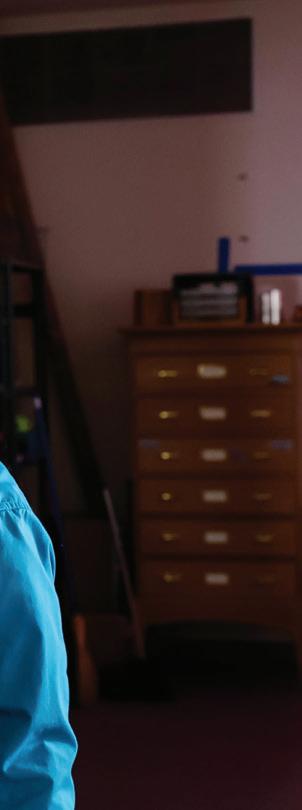
learn at Solar Car that the simplest of designs will sometimes work best,” she explains. “We also learn what it means to work with a purpose. Yes, we have the desire to win first place in the race, but the team knows its purpose is to build a better car each year through teamwork and innovation. And finally, students are taught that self-reliance is key.”
Bringing Innovation to the Heart of Campus
As the engineering program has grown, so has the need for it to be more physically central to Kent’s core landscape. To fully integrate engineering with the rest of the academic community, Kent’s senior leadership is considering plans to relocate the program from a building off-campus into the heart of the academic campus.
“As the conversation developed, and as interest in the program continued to grow, it became clear that it deserved to be foregrounded architecturally— reflecting its increasing academic significance and impact,” MacNeil says. “It’s still in the ideation phase, but if it comes to fruition, its status as a marquee
offering within the school will be sustained.”
The School has engaged architecture firm Ziger|Snead, based out of Baltimore, who conducted a conceptual review of the lower level of the Schoolhouse.
“That conceptual review led us quickly to the conclusion that this is great space for engineering,” Cataldo says. “It’s centrally located and visible to many, and it can be renovated, upgraded, and retrofitted. It also fits the size and flexibility needs of the program, both in terms of space and the type of equipment and furnishings we can bring in.”
As momentum continues, Cataldo says the school is considering how to raise the funds for the project. “We believe strongly that a project like this—one that’s so deeply student-centered— should be supported by those who care about enriching the student experience,” he says.
Bezerra says a central location will help students see engineering as a whole, combining classroom learning, activities, and capstone projects in a challengebased environment. It will also raise the program’s profile. “It’s about making engineering and the accomplishments we’ve made more visible,” he says. “And not just for prospective students, but also for our community. Engineering can and should be integrated into a liberal arts education.”
Real Tools for the Real World
An engineering background opens doors far beyond expected careers. “Engineering education, in many ways, functions like a highly desirable passport,” Bezerra says. “It’s not just for future engineers.”
Some engineers go on to careers
in law, tackling technical areas such as patent litigation or environmental regulation. The analytical and problemsolving skills developed through engineering are highly transferable. “Students who are not going into engineering are deciding that they want to be involved in one of our engineering projects,” he says. “They recognize the opportunity to expand their learning experience and to be a part of a group.”
In fact, Bezerra sees an engineering education as essential for students today. “I believe high school students should graduate with at least some exposure to different technologies and be aware of how engineering will tremendously affect our society in this century.” In this year’s upcoming Aerospace Engineering class, students will research how commercial aviation will evolve over the next 30 years. “Even skills on a smaller level, such as learning how to use simple tools, maintaining a positive mindset to repair something, or achieving a practical sense of how things work, are extremely valuable forms of applied knowledge,” he says.
He likes to imagine students walking around their neighborhoods and observing houses and identifying structural elements such as beams and columns, or noticing machine elements in home appliances, or understanding vehicle specifications—power and torque—when shopping for their first car. That’s when knowledge becomes meaningful. “That relevance—making learning visible in the world around them—is what sustains motivation,” he says. “When education remains purely abstract for too long, students may lose focus and interest. But when they can see its direct application, their motivation to continue learning grows.”
Opposite page, left: Shaun Neary`25, in action during scrutineering. He was one of the team leaders and main driver for the 2024 and 2025 races.
Opposite page, right: Engineering Program
Director Carlos Bezarra discusses the solar car with an engeering student.
Catching up with Seth MacFarlane ’91
By the time Seth MacFarlane ’91 arrived as a 14-year-old student at Kent School, he had already been publishing a weekly comic strip in the local Kent newspaper for five years. The son of two Kent School employees, MacFarlane grew up near campus, revealing his obvious early talent to a town and a school that embraced his creativity with “full-throated support across the board from day one.”
Throughout his time at Kent, MacFarlane continued to hone his skills in comedy, music, and theater, and as a cartoonist for the student newspaper, Kent News, deftly sketching out a four-year running commentary on school life. His talent led to a degree in animation from the Rhode Island School of Design (RISD) and has since evolved into a multi-faceted career as an animator, writer, actor, producer, director, comedian, and singer. He’s received multiple Emmy Awards (including four for Outstanding Character Voice-Over Performance, tying him for the most voice-over Emmy wins of all time) and been nominated for an Academy Award (Best Original Song) and five Grammy Awards
(including three for Best Traditional Pop Vocal Album). MacFarlane was inducted into the Television Hall of Fame in 2020 and has a star on the Hollywood Walk of Fame.
A common theme through it all has been MacFarlane’s use of his voice, whether breathing life into characters for the animated TV shows “Family Guy” and “American Dad!” or to the lovable, foul-mouthed teddy bear in the film and TV franchise “Ted” (season two is premiering soon on Peacock and a new animated series is currently in production), or using his distinct baritone to record his ninth studio album, 2025’s “Lush Life: The Lost Sinatra Arrangements”—and much more.
STORY BY Jana Brown PHOTO BY Pamela Littky

Two years removed from his induction into the Sill Society, MacFarlane spoke from Los Angeles with contributing writer Jana Brown about his time at Kent, his musical influences, the future of AI in animation, and why creative education is so important.
JANA: Your parents both worked at Kent. What were some of your favorite memories of growing up near campus, and what were some of your favorite places to explore?
SETH: I never lived on the Valley campus. I lived in a duplex that they offered us with four friends of mine up on the Hill campus, right next to the Cloutier’s house. But I was a day student for the first few years, and my mother worked in admissions and in college guidance, so it was a nice thing to be able to go hang out in her office after class for a little bit. It’s such a beautiful campus. Whenever I go back there, I’m reminded of just how stunning it is—the whole town is stunning, but I took it for granted when I was there. The place is like a beautifully landscaped park from end to end.
JANA: Any favorite places on campus while you were a student?
SETH: I don’t recall ever having a hangout spot of any kind, but that area next to the chapel that overlooks the hockey rink is very serene and tranquil. I remember they had that snack bar right next to Mattison Auditorium. I don’t know if it’s still there, but they used to make very good fries.
JANA: That’s a key to any campus, good fries, I believe, right?
SETH: Yup.
JANA: Your father still lives in Kent. When you come back, who and what do you see? What do you do? Is there a food you like to eat there?
SETH: The last time I was there, I had dinner at the Fife ‘n Drum, and Kingsley Tavern is always a must. Anna [Gowan] is an old friend, and she’s done an incredible job putting that place together. Those are the two spots I usually hit first. Swyft is also very good. I’ve only eaten there once, but it was excellent. Those are the three I’ve frequented recently when I’ve been back in Kent.
JANA: When you were at Kent, you were the cartoonist for Kent News. That wasn’t your first published work since you had a weekly comic strip in the local paper from the age of nine. Do you remember some of the subjects and the reactions they produced on campus?
SETH: That’s a very good question. It’s so hard to remember specific strips. I remember there was a character named Jack Kent who had sort of an Ed
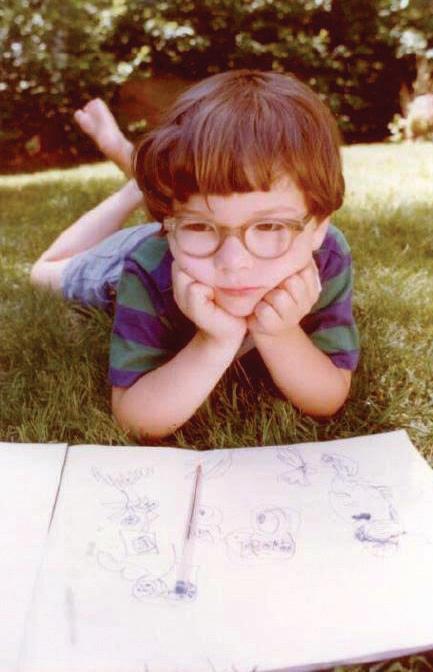
Grimley [of SCTV and "Saturday Night Live" fictional character fame] swirl to his haircut. I hope I’m getting this right. At the time, I think Tim Scott was running the paper for those four years, and he had titled the strip "Looking Up" during my freshman year; "Looking Out" during sophomore and junior years; and "Looking Down" in my senior year. It’s been a while, but I’m pretty sure he was the faculty member who was in charge of the newspaper, which made sense. He was such an incredibly dynamic teacher and made everything entertaining.
JANA: Do you remember people talking about what you were drawing?
SETH: Not in a granular sense. I remember I did caricatures of my teachers and of faculty, and I seem to remember those being used as kind of a freeze around the edge of the paper from time to time.
JANA: How did the early reaction to your
work, including in the Kent Good Times Dispatch and in Kent News, encourage you that you were on the right track creatively, and how has that continued throughout your career?
SETH: It’s funny, the Kent Good Times Dispatch [GTD] was a fantastic way to put my foot in the water. It did not take long to generate controversy, I do remember that. I think very early on, when I was about 9 or 10, I did a cartoon that had a guy at communion at St. Andrews, and he says, "Can I have fries with that?" And the local priest at the time sent a letter saying, "Shame on you for insulting the Almighty God and those who love Him." So that was certainly an introduction to what would become a much more frequent occurrence in my career; that is, stirring up controversy through cartoons.
JANA: Do you enjoy that, kind of pushing the envelope?
SETH: I don’t set out to do it. I set out to get laughs. Really, that’s the goal. If something is pushing the line at the same time, it always has to be justifiably funny first. So, I don’t ever really set out to

shock, but I think some of the things that are sacred cows in our culture, as they always have, lend themselves to satire, and that’s what was going on there. But I did that, I think from age 9 up through the day I went off to college, and then that’s when I stopped. But during that, at one point, I was doing cartoons for the local paper, which was the GTD, and then it eventually became the Kent Weathervane with Ed Rapp, and then I think went back to the GTD. It always amused me that a town that small had two papers. It’s kind of amazing. At the same time, for those four years I was at Kent, I was doing the cartoons for the Kent News, and so it was a town and a school that was, from day one, incredibly supportive of what it was that I was doing and what I was trying to do. I never had one person say, "Listen, can’t you have a backup plan and try and do something serious with your life as opposed to this nonsense?" It was just full-throated support across the board from day one, which tracks because it’s a very artistic town, so they get it.
JANA: You touched on this a moment ago, but satire is getting closer to reality these days. Is it getting harder to do satire?
SETH: There’s nothing you can satirize politically that’s any weirder or more outlandish than reality, certainly over the past 10 years. Political satire is in a very strange place because anything you joke about now has probably happened. I don’t think it’s gotten harder in a larger sense. I occasionally hear comedians, cartoonists, or comedy writers talk about how difficult it is. "You can’t joke about anything anymore." I don’t find that at all. I think that’s something that’s maybe been a little more sensationalized than it needed to be. I’ve found that comedy’s alive and well.
JANA: Tell me why creative education is important, not just to Kent, but in public schools, where it’s often the first thing cut when budgets are tight.
SETH: You do have to have a well-rounded pot of funding when it comes to that, because no one really knows at the end of the day exactly what they’re going to wind up doing. One of the things that was great about RISD when I went to college was that they showed you everything. You picked your major, and in my case, it was animation, but they

This page, left: MacFarlane’s "Looking Out" cartoon, 1990
Opposite page, right: MacFarlane’s "Looking Down" cartoon, 1991
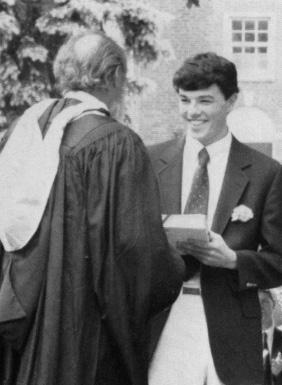

didn’t train me in one style. They taught me about hand-drawn animation. They taught me about animation using mixed media. They taught me about cutout animation. They taught me about stopmotion, about claymation. They gave me every tool imaginable, and when I left, I was well-equipped to explore exactly what it was I wanted to do. I think the same thing applies to the funding you’re talking about; you just have to allow for it all. There’s no rational reason to slash funding for art and music any more than there is to slash funding for sports. You’ve got to have it all.
JANA: You’ve recently recorded an album of previously unrecorded Sinatra songs. Tell me about how exciting this opportunity was, and what is it about this throwback Sinatra/Great American Songbook style that makes you incorporate live orchestras into your other work?
SETH: I was raised on acoustic music. I came from a very musical family. It was very important to them that music be a part of our upbringing. I was in the church choir directed by Marty Holcomb at St. Andrews for a number of years, and it was always something that was encouraged. I was a big film score fan as a kid. I loved when John Williams or Jerry Goldsmith or Elmer Bernstein or James Horner or Alan Silvestri would release a new film score. It was always exciting and stimulating, and I took that with me into adulthood and made it a part of everything I’ve done. I think it’s something that’s underrated. I think if you’re watching a show and certainly many television shows no longer use a live orchestra but when one does, even if the audience doesn’t know consciously that what they’re hearing is live music and that they’re hearing air
in the room, it somehow on a visceral level makes the show feel a little more important; it matters just a little bit more.
JANA: You’ve won several Emmys. You’ve been nominated for multiple Grammys and an Oscar. What draws you to work in the mediums of TV, film, and music?
SETH: I was raised on so many different disciplines. Obviously, I was drawing cartoons from a young age. I was involved with a lot of local theater. I played the trombone at Kent. There were a lot of different artistic disciplines that were part of the equation, and I didn’t want to give any one of them up when I came out here to work. I didn’t want to pigeonhole myself. What’s nice about working in animation is that it encompasses so many different disciplines. It’s visual art, it’s acting, it’s writing, it’s music. It allows you to keep all those muscles active and makes it so that no two days are the same.
JANA: Most aspiring creative people— writers, artists, musicians, animators, etc.—will not reach your level of success. Why is the creative process still worth pursuing?
SETH: You have to love it. I’ve never done this for the money or the success. I’ve done it because I love it. It’s just hardwired into me, and it’s all I know how to do. There really isn’t any other reason. For the first couple of years of my career, I was working but not making a lot of money. But I loved what I was doing, even though buying food was a little bit of a stretch sometimes. I couldn’t ever imagine myself doing anything else. Certainly, for me, and I think with everyone, it’s a combination of hard work and luck. The luck factor is always underemphasized. It’s timing. It’s pitching the right show at
This page, top: Seth MacFarlane awarded the art prize, 1991
This page, bottom: MacFarlane draws a cartoon for Kent News, 1990
Opposite page: MacFarlane as a student as RISD

the right time. I was pitching "Family Guy" right around the time when everyone wanted animation and a lot of it, and that certainly had an enormous amount to do with where I eventually wound up.
JANA: How do you think the rise of AI will impact the animation industry? Is it all bad or could it open up any new opportunities?
SETH: I don’t think it’s all bad. Like anything, AI, if used as a tool that can make your job a little easier and can shorten your day and allow you to do
the same job working eight hours a day instead of 14—which so oftentimes is the case in film, it has to be at least considered. I don’t think any of us are interested in seeing movies or reading books or scripts written entirely by AI at this point. The human connection between artists and audience is something I don’t think will ever completely vanish. It’s just too baked into our psyches. But you look at something like the evolution of the microphone. Sinatra recorded his earlier songs at Columbia with an RCA Ribbon mic, and
then when the Neumann 47 came out in the ’50s, I believe, he started using that because it was a better microphone and his recordings sounded better. So, I liken it to that kind of situation. If it’s a tool that can allow creative expression in a way that maybe wouldn’t have been possible otherwise, you can look at it like CGI. There are things CGI can do now that we weren’t able to do 40 years ago, and it’s opened up venues of storytelling. There’d be no "Jurassic Park" without it. So again, like anything, I think as a tool, it will have great potential. We just have to be responsible with how we use it. I know that’s the biggest cliché in the book, but it bears repeating.
JANA: Anything coming up soon that you’re excited about?
SETH: Well, we have "The Naked Gun" reboot [starring Liam Neeson] coming out in about a month or so, which was written and directed by Akiva Schaffer. And from me directly, we have season two of "Ted" coming out soon on Peacock. Those are the two big ones for this year.
[Editor’s Note: “The Naked Gun” was released in theaters on Aug. 1, 2025, and has received wide praise from critics and theatergoers. It is rated Certified Fresh on the Rotten Tomatoes Tomatometer.]
JANA: What’s the power of voice to you, whether in characters, in song, or as an advocate?
SETH: It’s just something I was born with and it’s, again, the luck of the draw. I was born with a useful set of pipes, so I use them. Really, it’s as simple as that. You use the talents you’re dealt, and there doesn’t seem to be any reason not to.
The Gunn Cross Once Again Atop Numeral Rock
By Larry Gile ’73

Memory Lane
Inspired to learn about Kent’s traditions, practices, and customs—some long lost, some still beloved—Larry Gile ’73 mined the School’s archives and interviewed dozens of alumni to unearth a treasure trove of history and memories.

This article is about the recent rebuilding of the Gunn Cross, which had, until recent years, stood atop Numeral Rock since 1929. It was erected as a memorial to Charles Berry Gunn, Jr., who died in February 1928, late in his Sixth Form year during a flu epidemic at the School.
A recent online Kent news article, “A Silent Sentinel Restored on Numeral Rock,” recounts how the Gunn Cross came to be and the roles played by the Gunn family, Gunn’s classmates, and the wider Kent community. While it touches on some of the same history, this article looks more closely at Gunn himself and the close-knit family he belonged to. Gunn was no stranger to Kent School when he arrived as a Fourth Former in September 1925. He was born in New Haven on March 10, 1908 (sharing a birthday with Fr. Sill), and apart from summers and holidays, lived in Scarsdale, New York. Most of his summers were spent at the Skiff family homestead on Skiff Mountain (very close to the former Kent Girls’ School), which had been (and still is) in the Skiff family since it was built in 1766. Fr. Sill, in a remembrance published in the Kent News, recalled how Charles, before entering Kent, would come down to campus to play tennis with his father and students spending the summer at Kent.


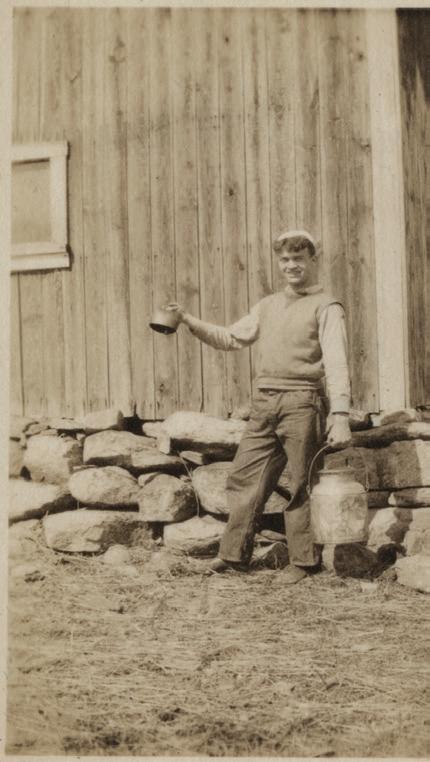
As a new student, Charles quickly entered into the cultural, athletic, spiritual, and social life of the community. He sang second tenor with the Glee Club and played for his form’s hockey team. The Kent News’ coverage of the annual fathers vs. sons baseball game in May 1926 mentions Charles playing right field and his father playing third base. During his Fifth Form year, he rowed on the Fifth Form crew, and in his Sixth Form year, stroked the combined Fifth and Sixth Form crew.
He exhibited a strong artistic and sensitive nature. The same weekend he and his dad competed on the ball field, he played piano in a concert for the fathers. The pieces he played were a Chopin prelude and Percy Grainger’s “Country Gardens.” A Kent News review of the concert said that while “critics are supposed to be bored by everything,” this was not the case that evening. The critic confessed to enjoying the performance and hoped Charles “will play more before the school in the future.” In the fall of his senior year, he provided piano accompaniment to the School orchestra and soon after played piano during a
school orchestra performance in which Fr. Sill played the fiddle.
A treasure found by Charles’ mother in his room at Kent shortly after he died was sheet music for a piece he composed, but was not able to finish, called “The Bobolink Waltz.” The cover for the music is his drawing of the bird known as a bobolink. According to Charles’ niece, Dr. Katherine Kane, both Charles and his sister Margaret took drawing lessons from the famous ornithologic artist, Rex Brasher, who lived in Kent. A number of beautiful drawings by Charles survive in addition to the bobolink. A pencil sketch titled “Hupmobile,” is a perfectly rendered drawing of a car Charles clearly loved, with a figure hunched behind the wheel with a farm (Skiff Homestead?) receding in the distance. For auto buffs, the Hupmobile was built by the Hupp Motor Car Company of Detroit from 1909 to 1939.
Charles was the eldest of four siblings: Katharine Ely Gunn (Polly), Pauline Day Gunn (Betsy) and Margaret Gunn (Margie). The current steward of the Skiff Homestead, Dr. Katherine Skiff Kane, is Margaret’s daughter and an invaluable source of information about the Gunn


family. Charles’ mother often called him “Sunny,” while in his sisters’s letters to him he is often called “Bub.” The many pictures and letters from Charles’ early days show a close-knit family, resilient in the face of tragedy. Photos give glimpses of their life on Skiff Mountain surrounded by pets (dogs, cats, horses, hens, and the Tobin’s turkeys), and enjoying sledding, skiing, and the more mundane matter of studying.
Fortunately, letters written to and from Charles from his sisters and mother survive, as do several from Charles to Fr. Sill. The letters exude mutual concern and affection, chronicling the joys and struggles of teenage years. In a letter from Charles’ mother to him during Fifth Form year, she tells him she would like to send him on a trip that summer to watch the Kent Crew compete at Henley (the first American schoolboy crew to do so.) This trip was in part to help heal the wounds created by Charles Gunn Sr’s. untimely death the previous October. His mother suggests a family friend, Charles Dunlap, as a possible traveling companion. She wrote:
Hush!!! Don’t breathe it aloud!! He is very
prominent here in Polly’s (Charles' younger sister) life. She is going to a hockey game with him Saturday. They write constantly and I want to know all I can about him. There is no way to get acquainted so well as traveling together.
While the two made the trip that summer, we do not know if the desired dossier was compiled and shared.
Another letter reveals Charles’ empathetic side. Charles wrote Fr. Sill on Saturday October 17, 1925 (less than a month after entering Kent), as the latter had been away from the School and was, as had been reported at the usual Saturday night assembly, homesick and yearning to return to School. Charles reported on recent athletic contests and says he, as well as the entire school, missed "Pater" and that Charles liked “to know you are around looking after things, and lecturing us when we are bad, and smiling when we are good.”
In a diary entry from January 1928, Charles wondered whether a girl he liked would want to go to an upcoming house party weekend with him. She did! Among the letters found in Charles’ room by his mother after his death was one
Opposite page, bottom left: Cover of Charles Gunn’s “The Bobolink Waltz”
Opposite page, top left: Gunn as a young boy
Opposite page, top right: Gunn after milking cows
This page, left: Gunn at 18, shortly before his death
This page, right: Gunn’s sketch of a “Hupmobile”
from an old family friend named Barbara McGlashan, postmarked February 1, 1928. Barbara had grown up on a farm next to the Skiff Homestead and her mother and Charles’ mother were best friends. Her family owned the farm that would eventually become the Kent Girls’ School. Barbara’s daughter was in the first Kent Girls’ School class.
Charles had known Barbara since early childhood and his invitation to the house party made perfect sense. She wrote: “I think it was awfully nice of you to invite me to Kent ... it was an awfully nice party I’m really very glad I went. Thanks loads for having me and all that you did for me.” She said that when she returned home on Sunday she didn’t feel well, possibly due to a lack of sleep. She said at the end of the letter, “Hope none of us left any scarlet fever germs.” She discussed whether she would be able to attend a glee club competition at Town Hall in New York City that Kent will compete at, being held February 4. While Barbara did not go, Charles did with the Glee Club. The day following the Glee Club’s return from New York City, he was admitted to the school’s infirmary, where he died of pneumonia on February 13, 1928.
Rebuilding the Cross
At some point during the Covid-19 crisis, the writer of this article learned the cross which had once stood atop Numeral Rock was no longer there. This set in motion a series of discussions and meetings leading to the School’s decision to rebuild the iconic memorial.
In the summer of 2024, Facilities Director John Bergin asked if any of his staff was interested in rebuilding the cross. Mike Rost, who had worked at the School for two years as a master carpenter, volunteered. While he had extensive experience in residential construction,
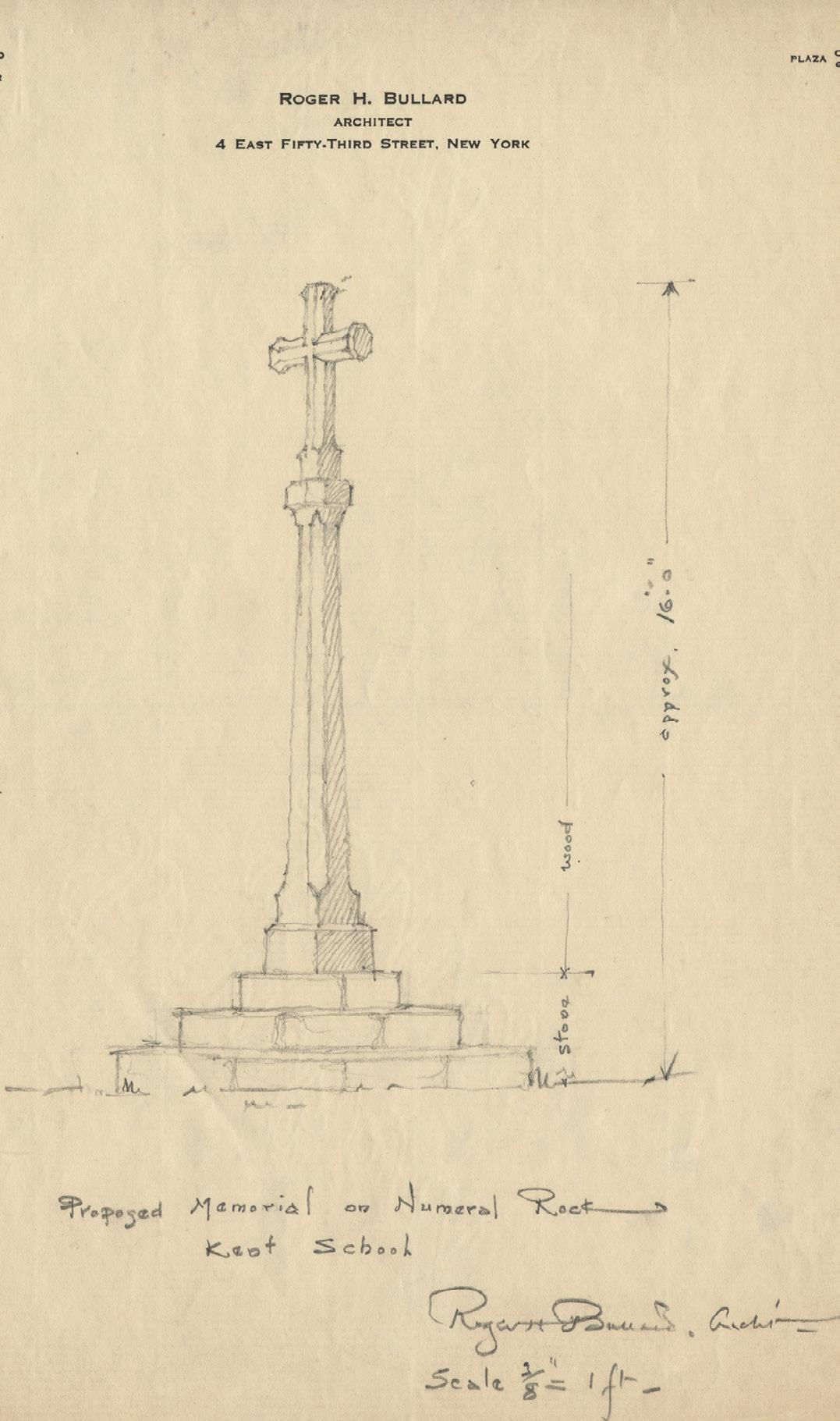



he viewed the challenge as unique, but within his skill set. Fortunately, drawings and photographs of the original cross were in the school archives and made available to Rost. The original cross was designed by Roger Bullard, father of one of Charles’ classmates and architect for St. Joseph’s Chapel. The wood used for the new cross is white oak and was purchased from New England Naval Timbers in nearby Cornwall, Connecticut, a firm providing timber for renovation of historic sailing vessels.
While the actual design and construction could fill a book of its own, here are a few highlights:
The original concrete base built in 1929 was still usable. Rost estimates the original base required over 100 bags of cement at 80 pounds, each as well as 150 gallons of water. Most of the supplies needed for the original cross were carried to Numeral Rock by students in what was a compelling example of love and self-reliance.
Over a nine-month period during construction, Rost applied linseed oil to the cross every day to make it more resilient and less prone to splitting.
The main upright weighs an estimated
400 pounds and the crossbeam, an estimated 200 pounds.
One of the most challenging parts of the project was constructing a “jig” that would facilitate drilling a 2 1/2-inch hole through the center of the upright, in which a galvanized steel pole was inserted and attached to the base.
In April 2025, members of the School’s Facilities Department cut a trail up to Numeral Rock, and sections of the cross were latched to universal terrain vehicles, and, with some difficulty, were brought up to Numeral Rock. On April 23, 2025, the Facilities crew secured a new base to the existing one on Numeral Rock and installed the main beam. The final horizontal piece was added the next day.
“A huge thank you to Michael for the time and dedication he put into building the cross, and to the entire Facilities team who helped make this restoration possible,” says Bergin. “Everyone took great pride in bringing this piece of Kent’s history back to life.” In addition to Rost, the project team included: Jeff Anderson, Luke Anderson, Willie Gawel, Charles Hayes, Eric McAllen, Robert Meley, Teddy Miner, Mark North, Josh Smith, and Kyle Summers.
This page, right: Master carpenter Mike Rost, Gunn’s niece Dr. Katherine Kane, Larry Gile ‘73, and archivist Katy Armstrong at the new Gunn Cross
Gatherings & Events



Kent’s annual New York City summer rooftop reception held this year at Bar Cima at the Grayson Hotel on July 31, 2025 brought together a mix of new and returning parents and alumni. Head of School Mike Hirschfeld welcomed the Kent community and acknowledged the many volunteers who helped us achieve great heights in the 2024-2025 school year. While we couldn’t capture everyone in our group photo, the evening was filled with fun moments and lots of connections. Wishing the summer night had lasted longer!
Gianna Espinosa ’24, Gaby Alias ’16, and Dana Burnett ’25
Yanni Nikolla ’10, Akim Jean-Charles ’09, and Chris Cravotto ’09




Alison Wearing ’98, Stephen Atkinson ’02, Dominique Paiement ’08, Michael Blundon ’06, James Lavinskas ’06, John Zambito ’20, and Vlad de Baghy ’02 came together for our first-ever international Supper Club on March 12, 2025, at the Burgundy Lion Pub in Montreal. A special thanks to James Lavinskas ’06 for hosting.
MONTREAL, CANADA
New York City Supper Club attendees Ashley Cooke ’98, Rindy Portfolio ’98, Craig White ’98, and Giff Foley ’98 had a great time at Octo in New York City on March 27, 2025
New York City Supper Club at the Lawn Club on June 10, 2025 Ashley Cooke ’98, Rindy Portfolio ’98, Craig White ’98, Giff Foley ’98, and Rachel Imbrogno ’96
RHODE ISLAND
NEW YORK CITY
Weezie Potter ’66, Barbara Trout ’76, and Pebbles Wadsworth ’66 hosted a summer reception at Birdview, Barbara’s family home in Jamestown, Rhode Island. Attendees included Elijah Duckworth-Schacter ’87, Barbara Gravdahl Trout ’76, Debbie Rinehart Fowler ’69, Pam Swan Connell ’64, Leslie Gleason Smith ’66, Weezie Potter ’66, Tom Potter ’69, Lynn Perkins and Perk Perkins ’79 P’11. Missing from photo is Gordon Potter ’68 and Adrian Burke ’88
NEW YORK CITY


On Thursday, August 14, Peter Getsinger ’71 P’02, Bob Hoerle ’52, Kim Naylor ’80, and Andy Smith ’94 P’25 hosted a cocktail reception with Mike and Liesbeth Hirschfeld at the Edgartown Reading Room in Martha’s Vineyard. Anticipating their 45th Reunion in June 2026, the Class of 1981 attended in strong numbers, proving their enduring connection.
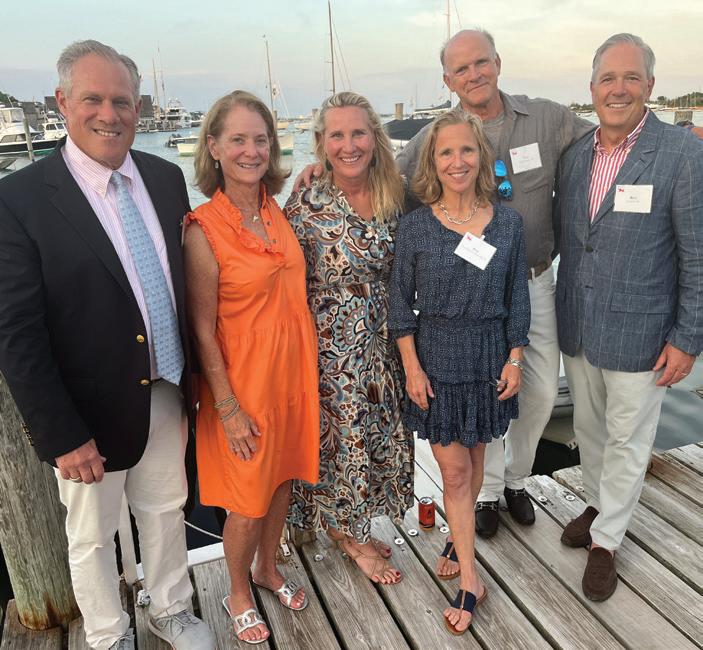
Class of 1981 members: Ken Southworth ’81, Elizabeth "Leelee" Klein ’81, Tracy Craighead ’81, Busy Reynolds ’81, Tom MacClarence ’81, and Rich Lindahl ’81
Parents and alumni gathered in Avon, Connecticut, on May 22, 2025, at a reception hosted by Andrea and Bill Moschella P’28. Guests included Michael ’95 and Raphael Ganchegui P’27, Kirsten Jaeckle P’28, Sarah Uphoff Dreyer ’87 P’27 and Sam Bell, Louis and Tara Sanabria P’25, Steve and Gosia Evanchik P’27, and Bill and Andrea Moschella P’28
AVON, CONN.
MARTHA’S VINEYARD
At the annual Blue and Gray Reception held in May, Sixth Formers were officially welcomed into the Alumni Association by the Alumni Council and the Alumni & Development Office. Rain moved the celebration indoors, but the spirit of the evening never faltered. The Old World Pizza Truck kept everyone well-fed with gourmet pies, while games of giant Jenga, cornhole, Connect Four, and more brought out plenty of friendly competition.
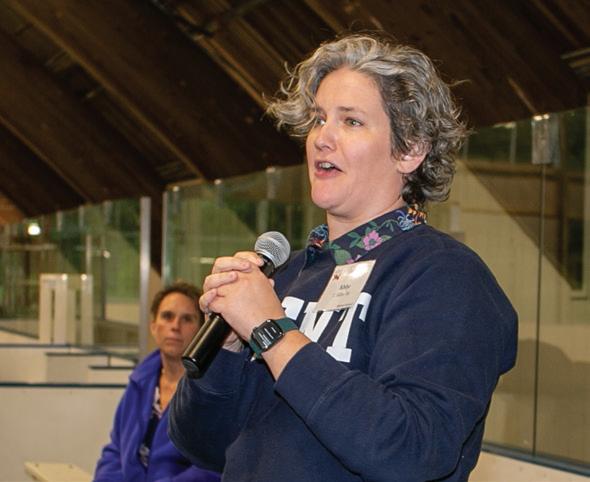



Blue & Gray Reception
Day of OutREACH
The Kent Community embraced the spirit of engaged citizenship and servant leadership during our annual Day of OutREACH in Kent and events held nationally during the month of May. Thank you to the students, alumni, faculty, families, and friends who showed up to make differences in their communities while connecting with Kent friends new and old. Keep an eye out for dates and locations in May 2026. If you are interested in hosting a volunteer event, please email alumni@kent-school.edu.

Muffy Mallory ’67 coordinated Kent School’s annual Day of OutREACH in the Bay Area at the San Francisco-Marin Food Bank’s Illinois Street warehouse in San Francisco, California. Volunteers filled 500 bags of produce, rice, and pasta—totaling 11,500 pounds— for distribution to local communities. “Some of us felt it in our muscles; who knew cauliflower and carrots could take a toll, but it was well worth it! We can’t wait for next year,” Mallory said. Thank you to this group for fulfilling Kent’s mission of contributing to the common good in the world beyond Kent School.
PENNSYLVANIA
Dave Taylor ’00 led the Day of OutREACH in the Philadelphia/ Wilmington area, where alumni volunteers joined the Hope Café event at CityTeam in Chester, Pennsylvania. After a tour of the complex, the group prepared the café for dinner service— setting tables and menus before taking on roles from food prep to serving and dishwashing. More than 50 threecourse meals were served, and the day sparked memories of working in Kent’s Dining Hall. Thank you to Team Chester/Philly for carrying forward Kent’s mission of contributing to the common good.

Monty Harris ’72, Dan Hoffman ’12, Christianna Sieverding ’11, John Rooney ’73, Dave Taylor ’00, and David Andrews ’76
Tim Stanton ’65, Jean Kocienda ’83, Marc Lieberman ’91, Muffy Mallory ’67, Dave Lamb ’01, Beth Ferree ’66, John Eaton ’66, Finley Rupright ’24, Annie Goranson ’91 P’24, Josh Rupright P’24, and Griffin Rupright
CALIFORNIA
Guilaine C. Jean-Pierre ’85 served as the Alumni Council Chair for Kent’s Day of OutREACH 2025 and arranged a service project at 5th Avenue Presbyterian in Manhattan on May 17 supporting New York Cares. Thank you to our to our amazing volunteers.
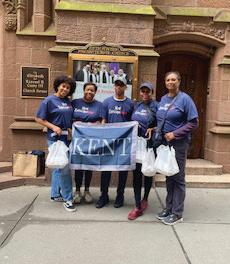
The Kent Community embraced the spirit of engaged citizenship and servant leadership during our annual OutREACH Day of Service.
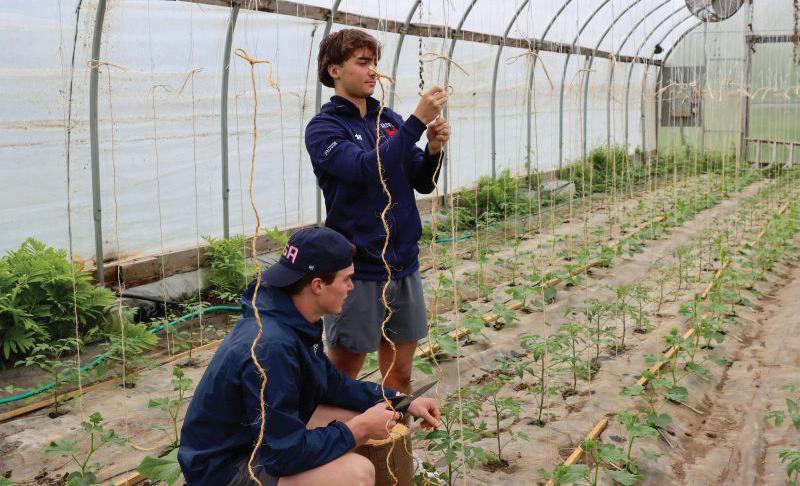
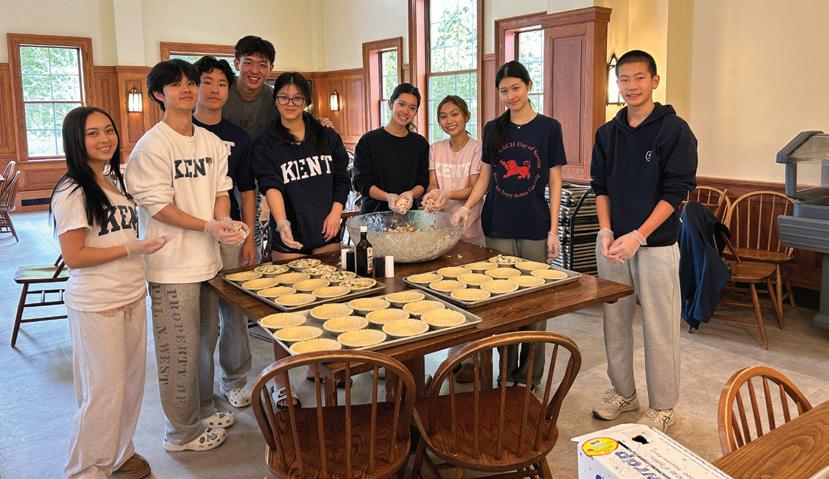
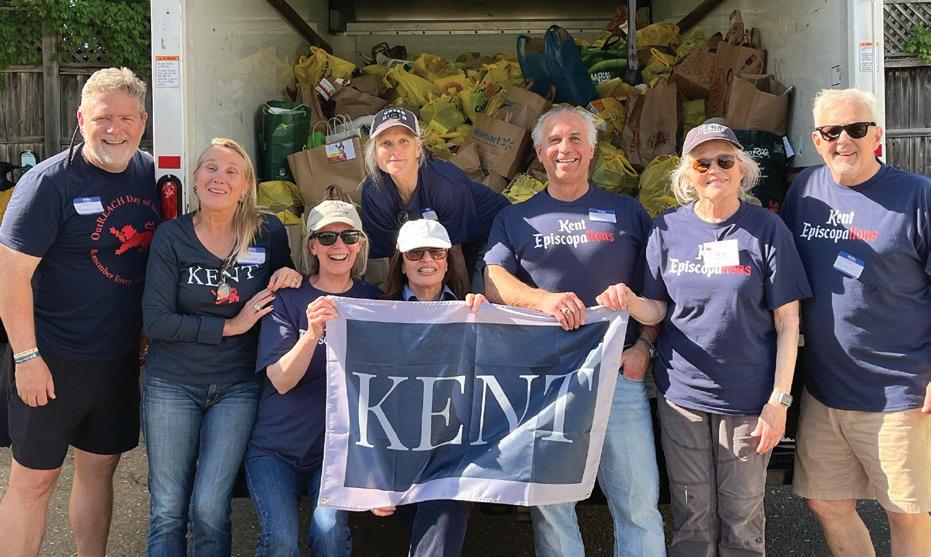
Tracy Craighead ’81 organized the Day of OutREACH in Norwalk, Connecticut, partnering with Stamp Out Hunger at the Norwalk Community Health Center. Craighead and a "small but mighty team" helped unload 978 bags of groceries from 43 mail trucks. “I am so grateful to everyone who gave up time from their busy schedules to join us in this effort, and I look forward to doing it again next year,” she said.
Misha Nonen P’28, Gilly Jean-Pierre ’85, Alicia and Jerry Sampson P’25, and Chaka Peters ’95
Chris Perry ’87, Tracy Craighead ’81, Libby Chapin ’67, Cornelia Fortier ’67, Larry Cohen ’78, Muffy Mallory ’67, Frank Dumoulin ’81, and Emily Zerega ’89 (back row)
NEW YORK CITY
KENT, CONN.
NORWALK, CONN,





2025-2026 Alumni Council and Parent Volunteers Highlights
Kent is pleased to introduce the newest members of the Alumni Council, Alumni Fund, Parents Association, and Parents Fund. Through their time, energy, and dedication, these volunteers strengthen connections across the Kent community and support the School in meaningful ways.
ALUMNI COUNCIL
Francois Anderson ’08 is a marketing and brand strategy professional and a proud advocate for the Kent alumni network.
Annie Goranson ’91 P’24 is Chief Compliance Officer at Okta, Inc. and a devoted Kent donor.
Myles Smith ’15 is a Project Manager in New York City and continues to be active in community initiatives, valuing the friendships he made at Kent.
Edward H. Tillinghast, III ’76 P’12 is a partner at Sheppard Mullin in New York and a longtime supporter of Kent.
THE ALUMNI FUND
Introducing Our FY26 Alumni Fund Co-Chairs: Returning for a second year, Barbara Vaughn Hoimes ’78 brings not only continuity but also a legacy of thoughtful leadership and unwavering dedication that has elevated the Fund’s momentum. We’re excited to welcome Erin Reilly ’08, whose dynamic creativity and proven leadership will build on this foundation—deepening alumni connections and expanding support across generations.
PARENTS ASSOCIATION
Kate Karafotas P’27 ‘24 and Lisa Sullivan P’27 are this year’s Parents Association Co-Chairs. They help bring families together and keep parents connected to life at Kent. The Kent Parents Association, a volunteer group working in partnership with the Alumni & Development Office and Admissions, is dedicated to building community and supporting all parents and guardians.
THE PARENTS FUND
The Parents Fund Co-Chairs, Stone Shi P’27 and Jennifer James P’26, are leading the way in supporting the School through fundraising efforts that directly benefit today’s students.
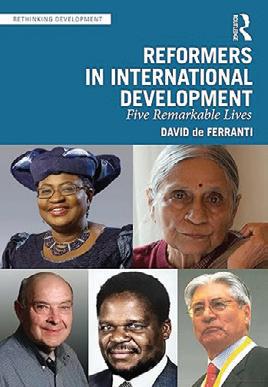
David de Ferranti ’63 Reformers in International Development: Five Remarkable Lives
ROUTLEDGE (2024)

Kazi Kuwahara ’69 A Thought on Japan’s Middle School Students’ Study Aborad Experience: Focusing on U.S. Prep Schools
DESIGN EGG (2024)
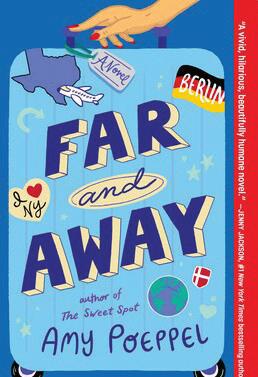
Mitchell Poeppel ’84 Far and Away
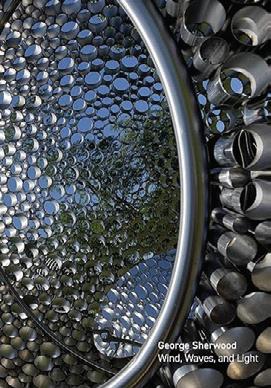
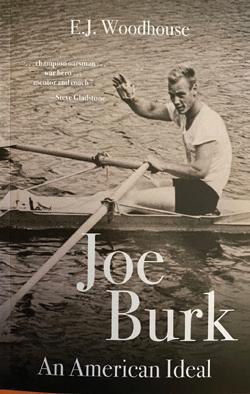
Edward Woodhouse ’71
Joe Burk: An American Ideal LYNNHAVEN PRESS (2025)
Amy
ATRIA/EMILY BESTLER BOOKS (2025)
George Sherwood ’72
George Sherwood: Wind, Waves, and Light
THE ARTIST BOOK FOUNDATION (2024)
Reunion Weekend 2025
Reunion Weekend 2025 was one to remember as alumni from classes ending in 0 and 5 returned to Kent for a weekend of connection, celebration, and reflection. The days were filled with familiar traditions, from class dinners and photos to the Saturday night dance.
The weekend also celebrated alumni achievements. The Classes of ’75, ’80, and ’20 set reunion records, with the Class of 1975 raising $253,000 for the Annual Fund and making additional commitments of more than $2 million.
For the Class of 2020, the return was especially meaningful. “What stood out to me most was the enthusiasm by my class, the Class of 2020, to return to campus and be together again,” said Ally Thanassi ’20. “We left Kent for spring break in March of 2020 and never returned to say goodbye to each other or the school—and it was so wonderful to be with each other again and have the ability to honor our time spent at Kent.”
The Class of 1985 reflected on both laughter and connection. “Each time I attend a Kent reunion, I am struck by the ease with which our class reconnects,” said Kim Koch ’85. “It’s as if no time has passed at all. There’s so much laughter, and genuine interest in what we’ve all been up to since we last met up."
Members of the Class of 1975 celebrated their 50th reunion with heartfelt moments. Kathy Crawford ’75 described their remembrance gathering: “One of the most poignant moments during our Class of 1975 lunch on the ballfield was our Remembrance of those we have lost. Anecdotes and legendary tales led to both laughter and tears, as well as a chance for us to connect with those in the class we did not know as well.”
Bruce Churchill ’75 also reflected on the milestone: “Fifty years is a long time ... Catching up with this group was the real highlight. The 50th reunion was a good chance to touch base with this broader group, have a laugh about what happened half a century ago, but more importantly to talk about topics of mutual interest. And finally, there is my connection with the school itself ... spending a weekend at the school helped solidify that perspective. Kent remains focused on its mission and deserves the support of its alumni.”
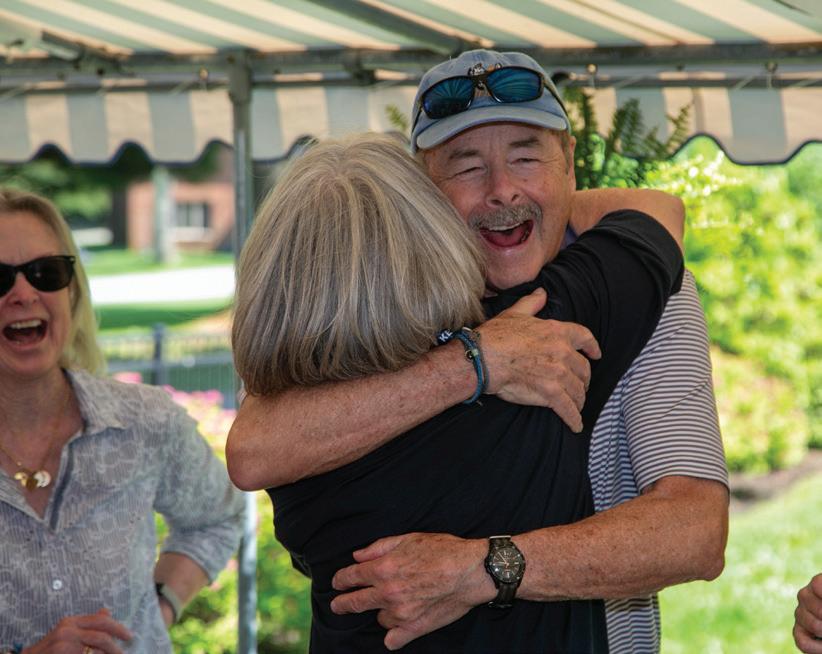
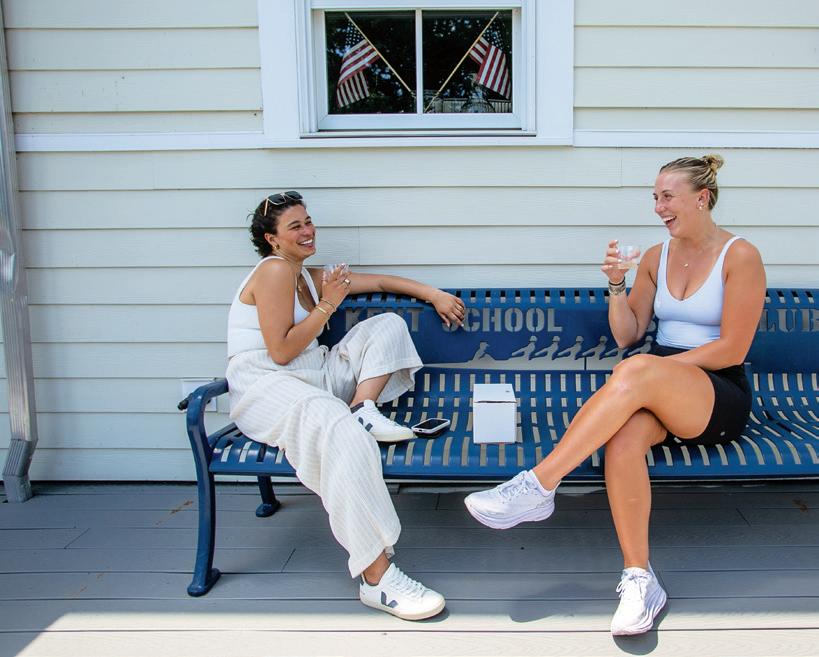






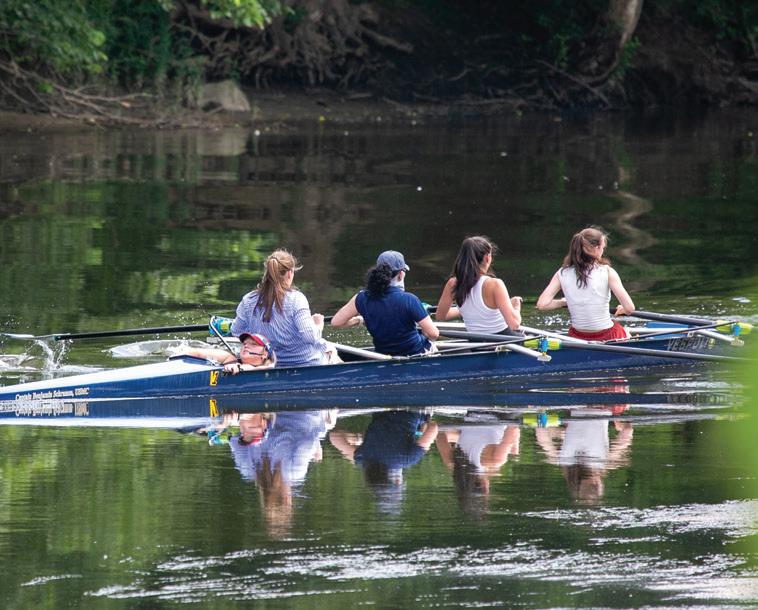



Class Notes
1949
A beautiful personalized Quilt of Valor was recently presented to Col. Bill Bernhard (ret), a retired surgeon and U.S. Army officer, in recognition of his 30 years of service in the U.S. Army from 1980-2010. These quilts are awarded to service members
or veterans who have been touched by war as an expression of thanks for their service and for their sacrifice in serving our nation. The quilt includes a listing of the many medals and badges Bill earned during his long and distinguished Army career. Bill’s military career began shortly after he graduated
from Kent in 1949, when he entered the Marines. He later served in the Navy Reserve for 10 years in active and reserve duty. As an Army officer in Iraq in 2005 and Afghanistan in 2006, Bill held the distinction of being the oldest person serving in combat. Thank you for your service, Bill!

1954
Lang Keith shared: ”I am still rowing almost every day. My daughter and I are going to race in the Mixed Double Sculls at the Canadian Masters Henley Regatta this summer. It’s a 1,000 meter sprint and thank goodness we get an age handicap (89 & 52 for an average of 70). After that, we will start training for the Fall “head races,” usually about a 3-mile slog. We are entered in the Parent/Child event at the Head of the Charles in late October. No handicap there, and many parents are rowing with their sons/daughters who row varsity crew at college. We are looking forward to the participation trophy!”
1960
This being Reunion Season, our class thoughts go in multiple directions back to our school days at Kent. Johnny Smithies was the first to offer a humorous recollection of an encounter with Mrs. Gilliam inviting Johnny and Freddie MacPhail to dinner. Johnny had just moved from his home in Cuba after Castro’s takeover, and Freddie was from Mexico. To entice the boys to come to dinner, she included they could watch the Ed Sullivan Show on TV. Apparently, both boys looked at one another and replied, “Who is Ed Sullivan?” Recently, former president of the Board of Trustees, Bran Sweitzer, attended our 65th Reunion dinner and reported that the attendees went through our 1960 Yearbook, voicing various fond recollections of each of us. Other
Col. Bill Bernhard (ret.) ‘49 with his Quilt of Valor.
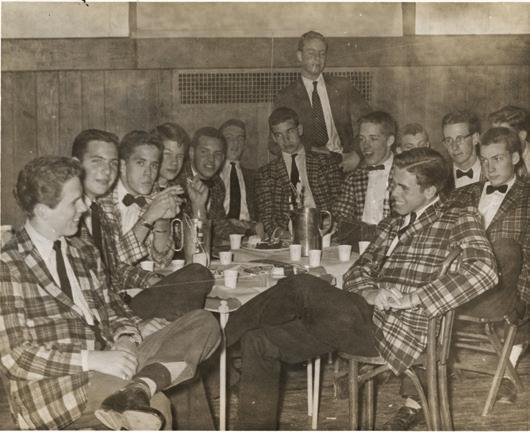
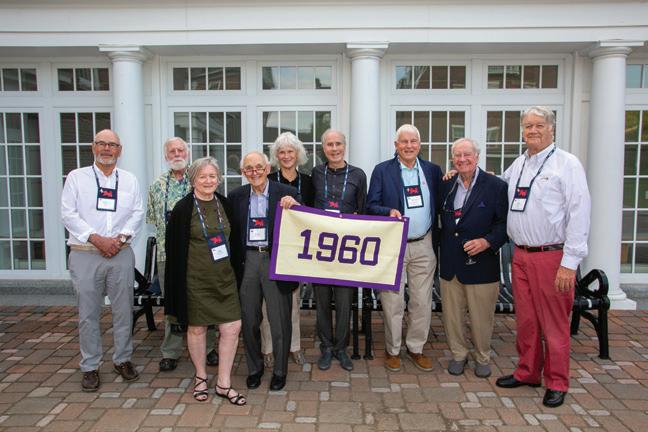
attendees were former Trustee and Treasure of the school, Bob Anderson, Class Agent David Kepner, former Class Agent Peter Alford, Dale and Bruce Morrison, Lyn and Tyler Smith and the winningest coach in collegiate rowing history, Steve Gladstone. Steve turned several less successful rowing programs into national champions, notably Brown, UC Berkley and Yale. A recent documentary, titled Full Measure: The Steve Gladstone Story, is accessible on Amazon Prime and at fullmeasurethefilm. com for rent or purchase. Steve’s incredible sixty-plus year career was fostered in large part by his relationship with Kent’s iconic crew coach of the ’40s, ’50s and early ’60s, Tote Walker ’19. Other news came from Ken Korfmann and English Exchange Student, John Ingham. Ken wrote that he and his wife, Sabina, continue to travel a lot. Most recently, they visited Istanbul, Northern Italy, Morocco and Cairo. Both Ken and Sabina are active in the communications consulting
field for the finance industry in Switzerland and England. They both remain involved in photographic projects, including making major contributions to Dr. Wolfgang Kersten’s second volume of “Photographic Thought Pieces”, 500 pages of which cover 8 more of their projects. This work will be published in September 2025 and can be viewed via open access or obtained on a print-on-demand basis from the University of Heidelberg. For further information, Ken specifies interested parties may search “Heidelberg Korfmann Kersten” or go directly to the following website: https://doi.org/10.11588/ arthistoricum.1377. Also, Ken has been spending time writing a journal daily for the past 25 years, recording activities and experiences. His journaling has produced 50 volumes and 11,710 pages! Finally, Ken wondered if it would be of benefit to our class to establish a video class meeting annually to bring us closer together and strengthen
our connection to Kent after so many years. What do you think, class? John Ingham wrote that he, too, is still travelling, having just returned from a week in southern Armenia with a botanist friend. Prior to that, John was in Peru for the whole month of May, revisiting archaeological sites along the upper reaches of the Maranon River in the northern Andes with archaeologist and drone camera colleagues. He said, “Now we need to work up all our materials to be published on a website, but that is well into the future”. Next to this information, news of the Mells in Kansas is sparse, other than a trip back East for our grandson, James’ wedding in mid-August and a trip to Maine thereafter that hopefully will include a visit with Hugh Hardcastle and his wife, Surrey. In a chance encounter at a local CVS in Miami, Johnny Smithies met the daughter of Charles Orr. Johnny reported that “I immediately recognized the name and told her that I knew
her father from working at The First National Bank of Miami from 1967-1970. He worked in the Loan Department and I worked at the Latin American Department.” If any classmates are interested in being in touch with Charles’s daughter, Genevieve, please reach out to Johnny through the Alumni & Development Office at alumni@ kent-school.edu.
1966 G
Leslie Gleason Smith shares: We recently received sad news of the passing in February of our dear classmate, Stina deVillafranca Hans, from cancer. Our thanks to Robin Gunther Lucas, who provided a lovely remembrance which I am copying here: “Stina and I kept in touch until Covid. I introduced her to her first husband, Richard, an electrical engineering senior while I was a freshman at RPI and she at Bennington, so we kept in
Members from the Class of 1960 at their 65th Reunion: Steve Gladstone, Peter Alford, Dale and Bruce Morrison, Lyn and Tyler Smith, Brandon Sweitzer, David Kepner, and Bob Anderson
Class of 1960 Dance Weekend (left to right): Fred McPhail, Warner Smith, Morgan Brookfield, Bob Anderson, Chris Clapp, Brandon Sweitzer, Dick Springs, David Kepner (standing), Tony Dunn, George Porter, Johnny Smithies, Blake Smith, John Skinner
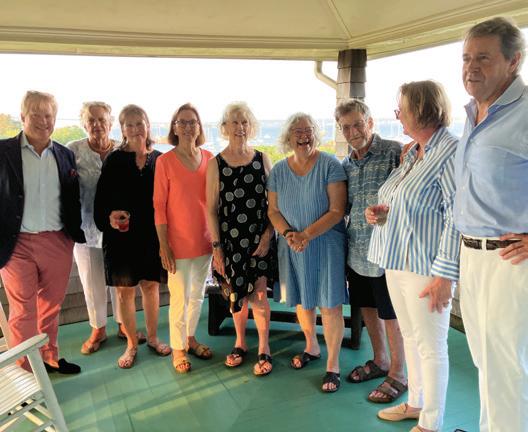


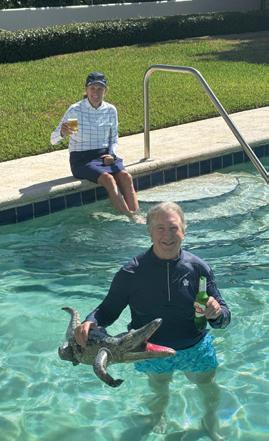
touch. I remember her spending hours with Betsy Savage designing women’s couture, and how happy she was about her clothing business and factory in L.A. She worked in the back of her limo between Santa Barbara and L.A. because the commute was so long, and she tried to keep her hours away from the kids to a minimum, as this was before cell phones and laptops. It seemed to me she had achieved her dream, but she kept on going. She was very proud of her children who did great in college. I never knew where she got her energy from. Next time I’m in Santa Barbara, I’ll drink a glass of red wine to her. Well done Stina!” For our 40th reunion book, Stina included an update on her life, noting, “Wwe are very thankful that our family is well and thriving. Certainly, for me this year has been a strong reminder to love, to laugh, to cherish one’s family and friends and the time we have together.” The email concerning Stina’s passing prompted many to write. Cindy Fryberger Cairney reported she was in Florida celebrating a high school
graduation for her 18 year-old granddaughter. The whole family is here and it is lovely to have everyone together. We will be doing a family reunion with the Fryberger family at the end of July, another fun event. Our oldest son is an airline pilot and we are blessed with flight benefits. Our children and grandchildren live in Florida, Colorado and Arizona so we travel about once a month to see everyone. We live in a 55+ community and it is a very active place to be. Judy Keur Toth responded she would miss seeing the ’66 contingency at the Alumni Cocktail get together in Jamestown, Rhode Island on July 17th, but that “she would be in Bristol on the 20th for our granddaughter to give us a tour of Roger Williams University, where she will be an architecture student in the fall. She is so excited to show us around!” Chichi French Armstrong had memories of sitting next to Stina in Chapel since [we think] we were seated alphabetically (for a challenge, try to remember who you sat next to!). She reports, “I’m
having fun playing jazz piano again, teaching vocal jazz to a young woman from Russia. She is a voice teacher but mainly works with pop music. It’s a cross of my music and my ESL work: besides listening to Ella Fitzgerald, I have to help her modify her Russian-accented English lyrics AND understand what the lyrics mean! Of course, we’re singing mostly jazz standards, many of which are now almost 100-years old and have lots of anachronisms or phrases no one really uses much (like “I’d like to add his initials to my monogram” - now that brought back memories of Kent and personally monogrammed clothing/jewelry). Jennifer Wolcott provided the following update on life in Washington State: “I was visiting my daughter in Highland Park for end-ofschool year fun when I tripped on a sidewalk. Emergency room and surgery to repair a broken patella followed, then 2 weeks in a nearby SNF. Home now in Issaquah for the rest of rehab. Knee is doing well, if slow, but the soft damage in my left arm is annoying to say the least.
We were supposed to be going to Williams 55th reunion this weekend in Massachusetts and various visits, but here I am. And our next trip to Panama in August is delayed. Also, I don’t think I will be meeting my goal of climbing the three Issaquah Alps (3-5K high) outside my door this summer. Bummer. Otherwise, most things are the same. We’ve been in our CCRC for more than a year and are settled in; friends took good care of Dan while I was gone. I’m getting used to not cooking when we are not in Panama. Dan is doing well too. Cheers to all.” Good luck on the three Alps Jenny, perseverance! I’ve just returned from the Jamestown, Rhode Island Alumni get together hosted by Weezie Potter, Barbara Gravdahl Trout ’76 and myself. We missed seeing Pebbles Wadsworth and Christian who were not able to join in the fun this year. The party was held at Birdview, Barbara’s summer home, which really does have a spectacular bird’s eye view of Newport Harbor. It was fun to meet up with Pam Swan Connell ’64
Peter Malin ’69 saves Mary Watkins ’69 from fierce ‘gator inhabiting her pool in Palm Beach Class of 1969 minireunion.
Jamestown Rhode Island cocktail gathering July 17th 2025. Left to right: Elijah Duckworth-Schacter ’87, Barbara Gravdahl Trout ’76, Debbie Rinehart Fowler ’69, Pam Swan Connell ’64, Leslie Gleason Smith ’66, Weezie Potter ’66, Tom Potter ’69, Lynn Perkins/Spouse, Perk Perkins ‘79, missing from photo: Gordon Potter ’68 and Adrian Burke ’88
Fred Schoch ’69 was in Seattle to present the Dutch Schoch Cup to the winner of the Cal vs Washington Men’s crew race and met Caroline McKallor ’78, who is married to one of Fred’s University of Washington teammates. Caroline remembers Fred from his years teaching English at Kent!
Mini reunion of 1969ers in Palm Beach May 2025. Sitting (left to right): Widget Crane Webert, Debbie Rinehart Fowler, Cathy Deming Pierson, Mary Watkins. Standing (left to right): Barbi Kingsbury, John Drinker, Katy Kuhner and Peter Malin

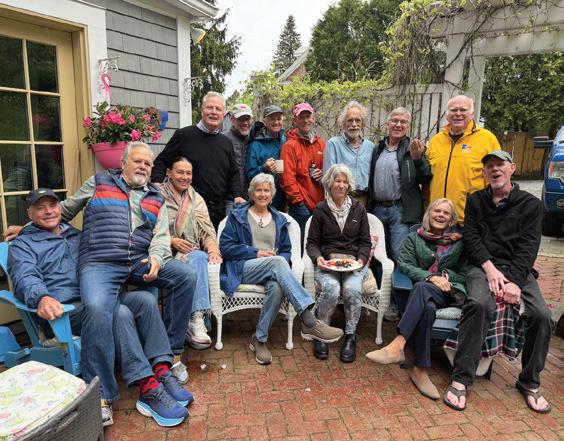

after so many years. Meanwhile, Pebbles and her therapy dog Inky have been involved in relief efforts following the horrible flooding on July 4 in Kerrville, Texas, not far from their home in Wimberly. She and Inky have been working at the Kerrville Reunification Center, where volunteers are helping families waiting to hear about loved ones. Disaster workers were familiar with Inky from previous disaster events, and were impressed at her ability to calm those around her. Pebbles says she feels blessed they are able to assist those in need. Finally, in August, I will be heading to Maine, as usual, to see what trouble Lynn Shipway, Weezie and I can get into. P.S. a reminder that next June we will be celebrating our 60th Reunion. More info to follow.
1969
Barbi Kingsbury writes, In early May 2025, several from our class had a meet-up, minireunion at the Palm Beach home of Mary Watkins and Reuben Johnson. Enjoying a few days
of golf, swimming, beach walks and wonderful, long dinners were Mary and Reuben, Cathy Deming Pierson, Peter Malin and Amy Malin, Katy Kuhner, Debbie Rinehart Fowler, Widget Crane Webert and Jim Webert, John Drinker and Diane Drinker, and Barbi Kingsbury. Peter Malin and Barbi Kingsbury shared: In 2019 at their 50th reunion, the class of ’69 created a fund whose purpose is to foster closer ties to the Town of Kent and the surrounding area. The Community Service Fund now has over $166,000 in its corpus and annually has about $6,500 available to support the community. Today anyone can direct their gift to Kent specifying this fund by letting the school know where to apply their gift. Directed by Megan Sokolnicki since its inception, Kent students work with area organizations. Kent sport teams, service clubs and activity groups contribute their time getting involved with community groups. These include the Kent Food Bank, Land Trust, affordable housing and Kent Historical Society among others. Janet Stroup Fox writes,
My middle grade novel, The Mystery of Mystic Mountain, has received numerous awards and accolades, including Library of Congress’s Montana Juvenile Great Reads Selection for the 2025 National Book Festival. Next up is a YA biography, The Real Rosalind, of biochemist Rosalind Franklin. Still carrying on in Big Sky country!
1975
Elizabeth Danielson shares: 50th Reunion! An epic weekend with about 60 classmates and 30 significant others. We enjoyed fun and laughter while sipping G&T’s in our one handed croquet match, told stories of the 9 of us who have passed, spent time having dinners and picnics, attempted to get our class photo taken several times, and broke all records of the number of classmates returning to a 50th and of the dollar amount raised to benefit the school and future students.
1979
Susan Smith Pettenati shares:
John and I are delighted to welcome our second grandson, William Terence Pettenati. Catherine Ericson shares that in February 2025, 14 members of the Class of 1979 enjoyed a fun and sun-filled weekend hosted, by Ernesto Alvarez and Diane deCordova, in Key Biscayne, Florida. While visiting Paris in April 2025, I spent time with Yvette Torell, who now lives in Paris. To see more photos from the Class of 1979, join our private Facebook page. Mary Lee Readyhough Blackwell shares: My latest exploits have given me an opportunity to connect with a dozen or so ’79ers in the past several months. Some, especially the guys, I may have known of while at Kent, but did not know. The reunions enabled us to connect and, in turn, opened up a whole new gaggle of friends. My husband, Lee, and I retired. We sold our home in Connecticut and bought a boat which was docked in Ft. Lauderdale, Florida. We are now sailing about like Gypsies through the Caribbean. Before we got here, I made several road trips up and down the eastern seaboard for various,
Members of the Kent Zoom Tribe from the Classes of ’74, ’73, ’72 and ’71 gathered in Vermont in early June. Back row (left to right): Terry Thoren ’71, Staige Davis ’71, George Sherwood ’72, Sandy Muther ’72, Ned Costello ’73, Tucker Allen ’72 and Dave Cherry ‘71. Front row (left to right): Vinnie Davis ’72, Basil Stetson ’71, Peggy Regusa (with Vinnie), Bev Cole Costello ’73, Betsy Tobin ’72, Laurie Ellis Bruckmann ’71, and Andy Phypers ’73. Also in attendance, but not in the photo Tom Clark ’72 and Mike Huffman ’73
Paul ’73 and Jan Pavlis enjoyed a three-hour dinner with Kazuo Mori ’73 and his wife in Tokyo in March.
Bruce McBarnette ’76 after winning the USA Track and Field Masters National Championships in the high jump in Gainesville, Florida.






mostly family, reasons. During those trips I connected with the following Class of ’79 alum: Dorsey Weber Gude, Catherine Ericson, Susan Condit Carey, Diane deCordova, Jennifer Thayer, Molly Armbrecht
Absolon, Ronnie Jackson, Bob Lierle, Ernesto ‘Neco’ Alvarez, Charlie Hurdman, Jamie Fargo, Bob Funnell, and Hank Reichner. Anyone who recalls my days at Kent, which weren’t exactly innocent, might find the humor in my hanging out with both senior prefects. But time— and a lot of it—has gone by and we all share a unique connection having grown up together under
the guise of Kent during our formative years. There is a bond, whether you knew the person then or not, that binds. For that, I am grateful.
1980
Ann Munigle shares: On my way back from visiting family in Virginia, I had breakfast with Cindy Schroeder and dinner with Pam Jordan.
1981
Tracy Craighead: shares: As I write this it’s another hot and
humid summer day and I have to think back over many months as to what Kenties I have seen since writing my last update. I am starting with the Kent Christmas party where we had many of the “usual suspects” attend including our very own: Jennifer Nichols Popp, Leelee Smith Klein, Alex Cross Mitchell, Abby Tyson Ciambrone along with one new face…Rich Lindahl! and another alum I personally hadn’t seen since he graduated in 1979 was Nico Alvarez! (who is living in Miami) and from that same class there was Charlie Hurdman who hadn’t been to a Christmas party in many,
many years and was in from Portland, Maine. (He happens to be married to a college classmate of mine and I saw them both again this summer at my 40th Colgate Reunion.) As already reported to you all, but certainly worth mentioning again here for anyone who may have missed the sad news, that Michael Wright passed on February 17. There was a beautiful service held at Kent in his memory and it was a lovely tribute with a number of classmates in attendance including: Tom MacClarence, Ken Southworth, Bill Bragdon, and Frank
Brad ’80
Dumoulin
In February 2025, 14 members of the Class of 1979 enjoyed a fun and sun-filled weekend hosted by Ernesto Alvarez and Diane deCordova, in Key Biscayne, Florida: Ron Jackson, Susan Condit Carey, Catherine Ericson, Jamie Fargo, Jennifer Thayer, Bob Funnell, Dorsey Weber Gude, Molly Armbrect Absolon, MaryLee Readyhough Blackwell, Diane deCordova, Bob Lierle, Hank Reichner, Charlie Hurdman and Neco Alvarez
Susan Condit Carey and Ronnie RB Jackson, Class of ’79
Catherine Ericson ’79 came up from Savannah, Georgia to visit Mary Lee Readyhough Blackwell while she moved her sister to Beaufort, South Carolina.
Reunion weekend dinner at the Fife ’n Drum on June 20, 2025: Holly Izant-McSharry ’80, Eric Houston ’80, Ben Wright ’80, Ann Munigle ’80, Tracey Bennett ’80, Von Brown, and Nate Brown ’80
Pam Jordan and Ann Munigle, Class of 1980, visiting in Easton, Maryland on June 16, 2025.
Laura Spink Chisolm ’81 with Emilie Christie Burack ’81 ran into one another at a New Hampshire Charitable Foundation Annual Meeting in June.

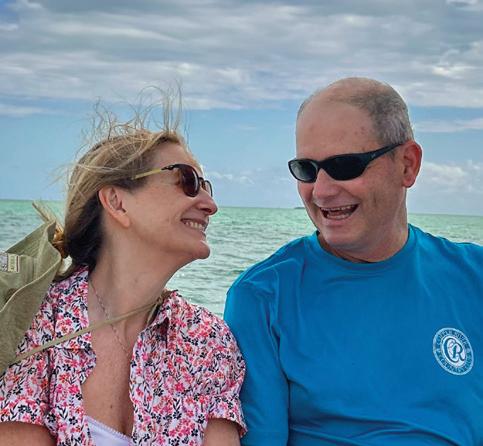
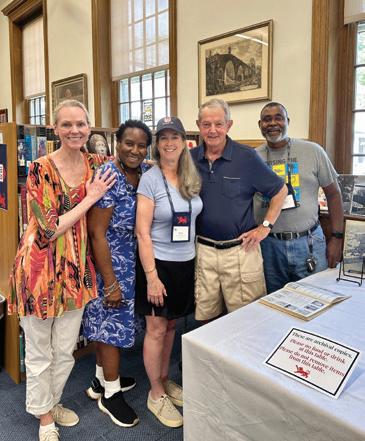

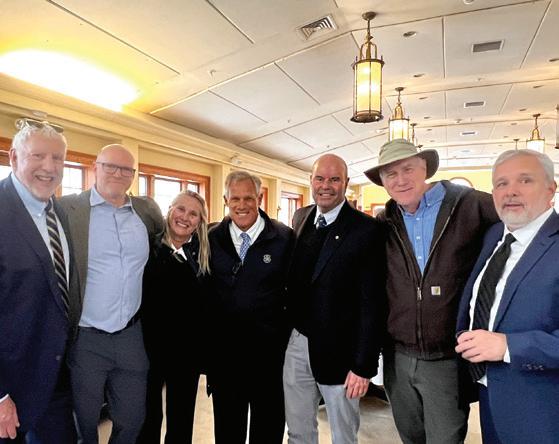

and I had dinner over the winter with Bill Landis and his wife, Meredith. Despite their living in the neighboring town of New Canaan, it was the first time we have seen him outside of a Kent event. We promised to change that and maybe even plan a local Kent gathering together. (Now that I’ve put that out there, we’ll be more motivated to make it happen!) In May we had our 3rd Kent Day of Outreach in Norwalk, and classmate, Frank Dumoulin joined us. It was great to have him there along with other Kenties from various years including Larry Cohen ’78, Libby Chapin ’67,
Cornelia Fortier ’67, Muffy Mallory ’67, Chris Perry ’87 and Emily Zerega ’89. Frank lives in Greenwich, but until this year, I hadn’t seen him since our college days when he was at nearby Hamilton College. (There’s more of a story there for another time but I will leave it with this teaser… someone was abducted from an institution of higher learning that night!) Speaking of higher learning, Emilie Christie Burrack’s daughter, Beatrice, graduated from Dartmouth this June and will be moving to D.C. and working on Capitol Hill. (Good luck Bea!) As well,
Emilie is gearing up for her 2nd Annual New Hampshire Book Festival to be held October 3-4 th in Concord, New Hampshire. It’s the perfect place to be in October—book your trip now! (Sorry, couldn’t resist). Emilie reported that this June she ran into Laura Spink Chisholm at a New Hampshire Charitable Foundation Annual Meeting and that Laura is working at UNH and lives in Exeter, New Hampshire with her husband who teaches at Exeter. (see photo) And while in L.A .this past June, Emilie chatted with Emme Entwistle Miller by phone. Emme had just moved
to L.A. before the fires struck and had to flee them but fortunately has since returned home. She is doing well in L.A. and is very much enjoying being with her daughter, Toby ’19, who is pursuing a career in film there. Laurie Stringfellow and I recently had our own great long catch-up over the phone. After officially retiring in 2023 and leaving Arizona (where she’d lived for 20 years), Laurie has landed in Denver, North Carolina (just north of Charlotte and where she is hoping to have somewhat cooler temps). She’s still settling in, but would love to see any Kenties who happen to
Catching up with Charlie Hurdman and Jamie Fargo, Class of 1979, in Florida
Jennifer Thayer and Bob Funnell, both Class of 1979, had some great laughs in Florida.
Members of the Class of 1980 with Cy Theobald at the Kent School Library on June 21, 2025: Ann Munigle, Tracey Bennett, Holly Izant-McSharry, Mr. Theobald, and Nate Brown
Tracy Greene Craighead ’81 and Frank Dumoulin ’81 volunteering at the 3rd Day of Kent Outreach in Norwalk with the Stamp Out Hunger Food Drive.
At Michael Wright’s memorial service in February at Kent: Fred Schoch ’69, Tom MacClarence ’81, Tracy Greene Craighead ’81, Ken Southworth ’81, Dan Traub ’79, Bill Bragdon ’81 and Frank Dumoulin ’81
Alumni from the Class of 1981 at the Kent Holiday Party: Jennifer Nichols Popp, Leelee Smith Klein, Alex Cross Mitchell, Rich Lindhl, Tracy Greene Craighead, Abby Tyson Ciambrone




live in the area or are just passing through. She expects to be spending more of her summer months in New Hampshire and maybe she’ll ultimately return to the New England area for good. (Fingers crossed!) I figure now is a good time to remind you all that our 45th, yes FORTY-FIFTH reunion is now scheduled for June 26-28th . (You should have already received a save-the date card from Kent.) So, no excuses. Please put it on your calendar now! You have plenty of time to lose those 10lbs, color your hair, whiten your teeth and/or upload favorite photos of your dog, horse, grandchildren, exciting travel, garden, guitar, boat, sports car or whatever it is that makes you proud. And please reach out to me if you would like to get involved in the planning for this event. I’d welcome the help and fresh ideas —and we all know it’s always more fun to do things as a team! And FYI, at my 40th college reunion many of us danced hard closing out TWO nights back-to-back —am talking until 2:30 a.m.! It was so great, and was made even sweeter when on the second night someone from the class of ’95 came up and asked if we were from the class of 2000?! HA! That can be us!! For those
of you who attended our 40th , remember our dancing to Earth, Wind and Fire’s, September? Let’s do it again—we’ll be a bit older (and stiffer), but with more of us out there on the dance floor, it’ll even be more fun!
1982
Michael Hoberman shares: “I have a book forthcoming (in early October) from Oxford University Press. The book is Imagining Early American Jews You can find more out about it
1983
Douglas Horner shares: Hi all, I am relaying some challenging news. Our friend & classmate, Tom Cleary, recently learned his kidneys are ‘essentially failing’. He had been preparing for a likely transplant several years from now but the timetable shifted with recent news. Yet a recent text from Tom stated, with a positive twist, “We will deal with it”. Well, this note comes with a purpose. It is a call to arms to the “WE” he mentions...our class of ’83, the Kent community, people you know, and to anyone that can help search for a kidney donor. Tom’s blood type, O-negative, is
rare but finding a suitable match is possible. Sadly, the current donor lists for Tom are a long way off. Finding a brave donor sooner than later is truly the mission at hand. Please send a note or call directly with any potential news, 917-975-0717. With luck, we will have a happier message very soon. Peace & love to Tom, Nancy and the family... and to all for taking a moment to listen and help pass along this vital request.” Keith Zelazny, Rich Mok, Kent’s Boys Varsity Lacrosse Head Coach, and Chris “CJ” Johnson ’85 played together on the 50+ team at the Lake Placid lacrosse tournament and shared many fond memories of Kent.
1985
Sandy Lowengart shares: Our class had a solid turnout for Reunion Weekend and it was great to be back on campus and experience the beauty of the Berkshire foothills and the Housatonic River. It was fun to catch up with an eclectic group of about 20+ classmates and remember the incredible experience we had 40 years ago. We had our Class Dinner Friday night at the Fife and
Drum and then Tim Hoy, Sandy Lowengart, Tom Bean and Brad Jacob reminisced into the wee hours of the night at the newly refurbished KPG outdoor bar. We also had a great dinner on Saturday at Anna Gowan’s ’95 highly acclaimed and outstanding restaurant Kingsley Tavern. We were fortunate to be joined by Bob Egermayer and Camilla Herrera as well as Reg Brack and his wife Jill on Saturday. Bruce Tarbox, not surprisingly, looked great in the 6-seat of the Alumni boat seated just behind two recent KSBC captains and former collegiate rowers who manned the stroke and 7-seats. Bruce continues to live in Portland, Oregan and practice law and his nephew was part of KSBC this last Spring, continuing a great legacy. Tim Hoy has lived in New Orleans since college and is still a Biopharmaceutical Executive while playing lots of tennis now that his lacrosse coaching days are over. He and his wife enjoy all that New Orleans has to offer and travel around to see their kids in Brooklyn and elsewhere. Brad Jacob relocated from the D.C. area down to Ponte Vedra, Florida and continues to practice law focused on the Energy industry. Tom Bean
Tom ’83 and Nancy Cleary ’82 in Saratoga Springs this summer during a meet up with classmates Graham Motion ’83, Kevin Coogan ’83, Doug Horner ’83, and spouses
Keith Zelazny ’83, Rich Mok, Kent admissions and boys varsity lacrosse head coach, and Chris “CJ” Johnson ’85 at the Lake Placid lacrosse tournament.
Amy Mitchell Poeppel ’84 was in Kent this summer to sign copies of her novel, Far and Away, at the House of Books.
Ted Rex ’85 and Eric Michael ’88 met up in Durham mid June, 2025. It was the first time seeing each other in 40 years!
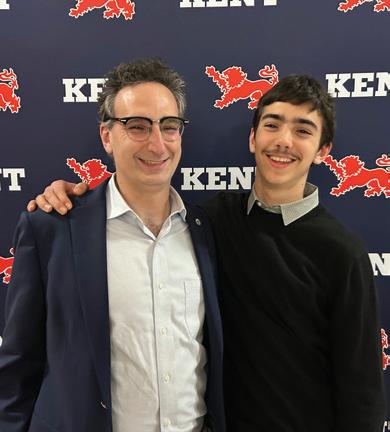


is still living in Virginia right outside of DC and continuing in high level tech sales. Bob Egermayer lives in New Jersey and recently sold his physical therapy practices to a Private Equity buyer and is working on winning some money back on the golf course from his son who played golf at Villanova. Kim Koch embarked on an epic road trip from Chicago to reunion, checking off numerous bucket list adventures and visiting distant family members along the way. After almost 20 years in San Francisco, Kim moved back to Chicago about five years ago to be closer to her family. She is still a highly sought after Digital Marketing professional. Reg Brack and his wife Jill live in Detroit, MI and have a daughter who is also a Kent Alumna. Reg is one of the foremost experts globally in luxury watches and is an SVP and Director of Jewelry and Watches at Hindman. In other notes from the field: Geoff Boyd splits his time between Dallas, Texas and an incredible property outside Missoula, Montana where he fishes, mountain bikes, rafts and flies planes. He tried to retire recently but after less than 18 months finds himself back in his veteran role as a CFO, this time at Private
Equity backed company Mindr. Chuck Mills is raising a family in Connecticut and continues his Private Equity career at V&A Capital where he is a managing director, and kayaks and surfs every chance he gets. Roland Rogers is doing well and still living in New Rochelle, New York, running his IT Solutions business. Sandy Lowengart splits his time between Marin County California and West Palm Beach, Florida with his wife of 32 years, Annie. He is still a professional money manager and is getting used to the new “empty nest” lifestyle and fully embracing it! His daughter Elizabeth is in her third year at Goldman Sachs in San Francisco and his son Ford is a rising Junior at TCU after decommitting from a full ride to play college lacrosse. He sees Craig O’Callaghan who is living his best life with his son Gus on the beach in Palm Beach, Florida.
1986
Elizabeth Courtney shares: Mark your calendars for our (gulp) 40 year reunion, June 26-28, 2026. Everyone is required to attend. I’ve spent a lot of time knocking around Kent the past few years. My
daughter, Marielle, graduated in 2024, along with Luc LaFontan’s daughter, Elle. We also frequently saw Andrew Georges at crew regattas. His son, Alexander, graduated in 2023 and he has another son who is a fourth former. Jen Kuratek Seidel is a new Kent parent. Katherine Gauthier also has a son who just graduated in 2025. My niece, Ainsley, (Sarah Dreyer ’87’s daughter) is a student at Kent now. So much fun to see our kids experiencing the new generation of Kent. My son is a student at Northfield Mount Hermon, but I don’t hold that against him. After years of raising kids, I’ve started a new chapter in my life writing novels and essays. I had a Modern Love essay published in The New York Times last summer-great way to kick off my career as a published writer. Even better news, I won a contest sponsored by the Yale Writers’ Workshop and my debut novel, Latin Club, will be published by Woodhall Press in May, 2026. When I’m not writing at home in Southport, Connecticut, I love catching up with Kent friends. Elizabeth Driscoll is living in Plymouth, Massachusetts. She got married two years ago to Douglas Lovell. Clare
Powell is living in Wellesley, Massachusetts, but has hosted a bunch of us several times out on Nantucket, including Driscoll and Julia Armstrong. When Jules is not scaling mountains in the Alps, she splits her time between Charleston, South Carolina and Montana. Jen Casazza Boland lives close to me and she and I did a 100,000 meter erg challenge this winter. Heidi Stultz Brooks is showing how leadership is done at the Yale School of Management, and also contributing some of her expertise as a trustee at Kent. Alicia Coppola is not only a talented actress but she also wrote and directed an awardwinning short film called ‘And You Are?’ starring Jane Seymour. I saw Catherine Corson in Wynnewood, Pennsylvania, when I took my daughter to see Taylor Swift. Catherine is the Academic Program Coordinator at Drexel University’s School of Public Health. Please plan to come to reunion!
1996
Tommy Vitolo and Jennifer Taranto are delighted to report that their son, Felice Vitolo, will be attending Kent School, class of 2029!
Tommy Vitolo ’96 on campus with his son Felice Vitolo ’29 on the day Felice decided to attend Kent School!
Juan Miguel Hurtado ’98, Guilherme Coelho ’97, and Rodrigo Alejos ’97, 27 years ago at Prom
Guilherme Coelho ’97 met up with his former classmate Rodrigo Alejos ’97 in Guatemala City.


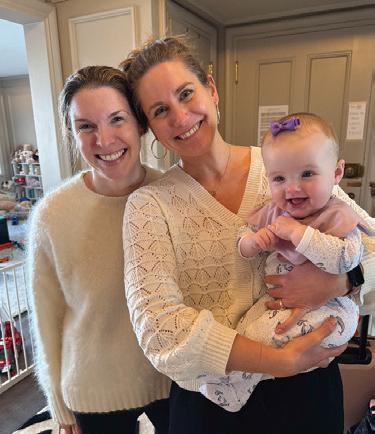
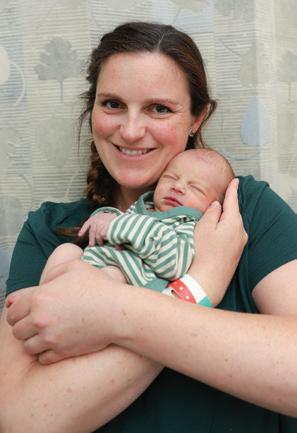
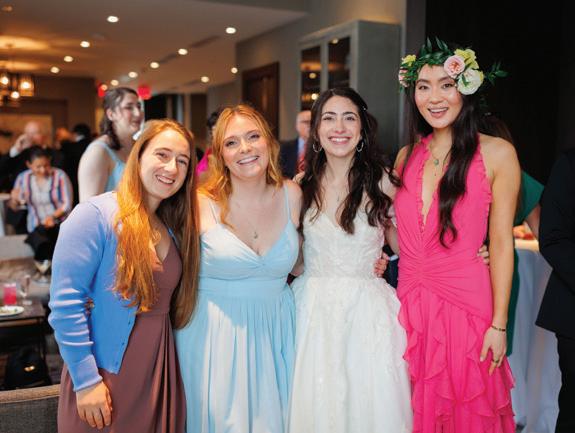

1999
Patrick Buckley has been enjoying raising his five children in Boise, Idaho. They have been flying in the frank church wilderness, rafting, fly-fishing, and hosting Kent friends like Kevin Quat and Chris Cassin. Patrick is licensing his patents and continues fighting Google in court.
2000
Allie Janson Hazell visited Alexandra Reese Murray in San Francisco to celebrate the arrival of her second child, Marlowe Jill Murray, born on July 21, 2024. Baby Marlowe joins her proud big brother, Michael, who is two years old.
2016
Christina Lyons shares: I married Charles Dwyer in May 2025 in Portsmouth, New Hampshire. Members from the class of 2026 including Maddie Kabasakalian, Shannon Ambrose, and Eugenia Zhang attended the wedding.

A reminder to our readers and contributors In our Class Notes section, we take great care to edit submissions for style and brevity while preserving the accuracy of the information provided. However, it’s important to note that we do not alter factual content. The information shared by our alumni is presented as accurately as it is received. Any discrepancies or inaccuracies should be brought to our attention for verification and correction.



Lincoln, Emilie, Regan, Kennedy, Patrick Buckley ’99 on Mother’s Day
Patrick Buckley ’99 flying in the Frank Church Wilderness with Alex Polvi.
Alexandra Reese Murray ’00, Allie Janson Hazell ’00 and Marlowe Murray in San Francisco
Hillary Clifton ’08 with her first child Thomas Clifton Jakubiak
Class of 2016 members Maddie Kabasakalian, Shannon Ambrose, and Eugenia Zhang at Christina Lyons’ wedding
Mohamed Khalid ’17 and Kurt Schroeder ’84 met up in Madinah, Saudi Arabia last spring. Mohamed had traveled from Maine, and Kurt from Colorado to make the pilgrimage to Makkah for Umrah during Ramadan. Mohamed and Kurt first connected on LinkedIn.
Class Volunteers
Email your class notes to a class volunteer from your year or send your notes to alumni@kent-school.edu
195o
Dick Thompson tootie218@gmail.com
1951
Peter Hurd pkhurd@optonline.net
1952
Bob Heidenreich robt.heiden@gmail.com
1953
John Moore Jcmoore3@msn.com
1955
Dick Sanford SaraCHS@aol.com
1956
Bart Bates bartb8s@aol.com
Jay Banker jaybanker@aol.com
1957
Peter Fairchild pwf@sbcglobal.net
1959
Wink Bangs Wdbangsjr@aol.com
1960
Dave Kepner djkepner47@gmail.com
Jim Mell stepaheadcounseling@gmail.com
1962
Sam Watkins samwatkins184@gmail.com
1963
Hap Allen hap.allen@mac.com
1964
Trudy Ashcroft Smith bbtsmith@aol.com
1965
Ginny Martin Amsler useppagin@aol.com
Peter Lewine Plewine@gmail.com
Margo Ayres Smith mayressmith@gmail.com
Bill Williams briobrio33@gmail.com
Judy Kapp Winder Jkappwinder@gmail.com
1966
Doug Henry ddhenry1@gmail.com
Leslie Gleason Smith Lsmith5893@aol.com
Pebbles Wadsworth pebbles@utexas.edu
1967
Muffy Mallory mmallory10@comcast.net
Peter Patch PeterPatch@aol.com
1968
Libby Koponen libby.koponen@gmail.com
Stuart Niemtzow stuartnlaw@gmail.com
1969
Barbi Kingsbury barbkingsbury@gmail.com
Peter Malin peter@themalingroup.com
1970
Adele Eissler Young adele.e.young@gmail.com
1971
Robin Bodell rabodell220@gmail.com
Staige Davis staige.davis@fourseasonssir.com
1972
Ric Burwell ucsb1977@comcast.net
1973
Bev Cole Costello bevcoz1@gmail.com
Marguerite Heilman mar67855@gmail.com
Andy Phypers aphypers53@gmail.com
1974
Anne Hyde Dunsmore adunsmore@cap-camp.com
1975
Beth Danielson elizabeth@edanielson.com
Mark Vollmer mvollmer@inspirepro.com.au
1976
Dave Andrews revdup1@comcast.net
Michael Perry mdp06897@mac.com
1978
Suzy Bird Gulliver suzybird@aol.com
1979
Catherine Ericson cericson@gmail.com
1980
Ann Munigle armugs@hotmail.com
1981
Tracy Greene Craighead tracycraighead@hotmail.com
Tod Perry tod.perry.tp@gmail.com
1982
Mary Carroll Goodsir megoodsir@gmail.com
Rohan Goodsir rgoodsir@gmail.com
1983
Sayre Coombs sayrecoombs@gmail.com
Robin Insley robin@robininsleyassociates.com
1987
Jim McKeown boilerhit@hotmail.com
Holly Comer Zapf sonnenschein2@me.com
1988
Peyton Carter winged_lion_pfc3@yahoo.com
1989
Derek Krein dkrein1@gmail.com
1990
Andrew Bogle andrewabogle@gmail.com
1991
Tex Duncan texd@texd.com
1994
Alicia Pokoik Deters apdeets@gmail.com
1995
Michael Ganchegui gancheguim@kent-school.edu
Robyn Holt robynholt@gmail.com
1996
Sally Smith Betz ssbetz@hotmail.com
1997
Kristine Palmero palmatina@gmail.com 1998
Giff Foley GiffFoley@hotmail.com
1999
Pat Buckley prbuckley@gmail.com
Carrie Flickinger Diana carriefdiana@gmail.com
Brian McKenna bpmckenna11@gmail.com
2001
Heather Cocce Leins heatherleins@gmail.com
2002
Carrie Schenk carrie.schenk@gmail.com
2004
Meg Dodge medodge@gmail.com
2006
Kathleen Hearn hearn.kathleen@gmail.com
2007
Becca Andreoli rjtandreoli@gmail.com
Anna Sanders AnnaESanders@gmail.com
2008
Kara Ruskin Billington kara.ruskin@gmail.com
Hilary Higgins flack.hilary@gmail.com
Amanda Ward Marshall amandawardmarshall@gmail.com
2009
Mark Cheong markacheong@gmail.com
2011
Lauren Sweitzer sweitzerla93@gmail.com
Morgan Weaver morganbweaver@gmail.com
2014
Andrew Liddle aliddle33@gmail.com
Meghan McSharry mamcsharry@gmail.com
2015
Andy Provost andy.provist@gmail.com
2016
Blair Stratman blair@moreira.com
2017
Katie Voulgaris kavoulgaris@aol.com
2018
Tina Paolillo
Tina_paolillo@alumni.brown.edu
2019
Savannah Adamo savannahadamo20@gmail.com
2020
Katherine Herrema katherine@herrema.com
2022
Yuanqin Dai AlbertDai2003@gmail.com
Benjamin Michaud Bang benjamin.mbang@gmail.com
In Memoriam
1943
Stuart Symington Jr.
July 16, 2025
1945
Col. Robert E. Whitelaw (Ret)
March 30, 2023
1946
Robert W. Esmond
April 22, 2020
1947
Trubee G. Racioppi
December 29, 2023
1948
J. Newton Nash
May 29, 2025
1949
W. Stevens Sheppard P’79
March 29, 2025
Kenneth S. Roberts Jr.
April 14, 2025
Charles H. Mott
July 1, 2025
1950
Andre Guilliano
March 13, 2025
1954
Thomas H. Richardson
March 1, 2025
John H. Riggs Jr.
August 28, 2025
1955
H. Rutherford Turnbull III
March 17, 2025
George H. Wehmeyer
2024
1956
Robert B. Lawlor
March 14, 2025
Foster Devereux
April 29, 2025
Frederick C. Moffatt
July 23, 2025
1957
Henry A. Truslow III
July 10, 2025
1959
Howard D. Wolfe Jr.
July 12, 2025
1960
R. Douglas Ahlborn
March 18, 2025
Richard A. Springs III
September 9, 2024
1962
C. Chase Hewes GP’26
March 6, 2025
Richard Frohmader Jr.
May 23, 2025
1963
Pamela Middleton Drumm
January 17, 2025
1965
Rev. Levering B. Sherman Jr.
August 12, 2025
1966
Stina de Villafranca Hans
Febraury 26, 2025
1968
James J. Smith
December 24, 2023
1969
Bruce H. Houghtaling
April 5, 2025
1972
Edward C. Peterson
July 1, 2025
1976
David A. Zysik
Febraury 24, 2025
1979
Richard T. Koenig
August 12, 2025
1985
Frederika A. Brookfield
July 9, 2025
FACULTY/STAFF
Charles Genovese
April 29, 2025
Patricia S. Genovese
March 23, 2025
PARENTS
Barbara D. Glass P’02 ’05
July 14, 2025

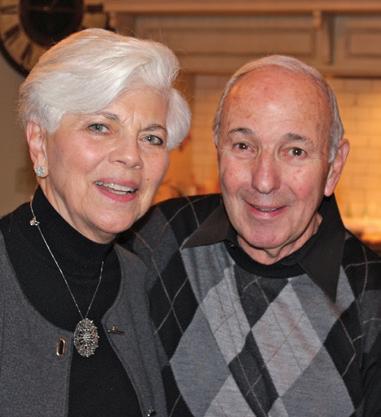
Charles & Patricia Genovese P’82 ’
84
Retired faculty member Charles S. Genovese and his wife, Patricia, passed away this spring in Marietta, Georgia. Charles passed away on April 28 at the age of 92. Pat passed away on March 23 at the age of 89.
Charles graduated from Brown University in 1954, where he earned a bachelor’s degree in English and American Literature with a minor in English Expression. He subsequently attended Boston University School of Law before being drafted into the Army and serving with occupation forces in Germany. After returning to Boston University two years later, he changed educational course, earning a master’s degree in English in 1958.
Charles married Patricia in the summer of 1961 before joining the Kent School faculty as an English teacher that fall. At Kent, Charles taught English at all levels, coached junior varsity baseball and intramural basketball, and umpired football. He served as a faculty advisor to students on the Girls Campus and was the faculty leader for Catholic students. Patricia worked in the Admissions Office at Kent from the early 1980s until Charles retired from teaching in 1997.
In an interview with the Kent News when he retired in 1997, Charles reflected, “I’ve learned much from the students here. It’s been a teaching and learning experience for me in and out of the classroom and on and off the playing field. I’ve learned from my players and students who have pressed me to question values and measure myself. They are largely responsible for my own learning in life.”
Charles and Patricia were married for more than 63 years, and their lives together were filled with much happiness and joy. They were predeceased by their grandson, Raymond E. Baltz, III, and are survived by their children, David A. Genovese ’82 (Camilla A. Herrera ’85) of Stamford, and Pamela G. Baltz ’84 (Raymond E. Baltz, Jr.) of Atlanta, and their families.

Kenneth Somers Roberts 1949 GP’03
Former Kent School Trustee Kenneth Somers Roberts died peacefully on April 14, 2025, at his home in Cannon Falls, Minnesota. He was born April 9, 1930, in Cohansey, New Jersey. After graduating from Kent in 1949, Ken attended the University of Pennsylvania, Wharton School of Finance and Commerce. Ken served as a Trustee from 1994 to 2007 and was a longtime Class Secretary for the Class of 1949.
Ken’s work ethic was exceptional, and his integrity and discipline were second to none. In 1955, Ken began his career at General Motors Acceptance Corporation. His next endeavor took him to Yegen Associates from 1966 to 1970. With much determination, he started Consolidated Acceptance Corporation. From 1977 to 1983, Ken was at Consolidated Financial Corporation. In 1984, he was the Executive Vice President and Chief Operating Officer at Greentree Financial, where he also served as a Trustee. In 1995, Ken started United Companies Funding, Inc. Ken ended his career at Triad Financial Corporation in 2002.
He spent his retirement years traveling with the love of his life, Annette Mansfield. He was also actively involved with the Boys and Girls Club of Minnesota. Ken is survived by his two daughters, Laura (Marc) Blais and Beth Marie Edwards, and their mother, Susan Roberts. He was granddad to April, Dianna, Ryan, Ellen, James (Kent Class of 2003), Breanna, and Austin. He was also fortunate to have had great-grandchildren Vivian, Violet, Edwin, June, and Annabelle.
Reunion Weekend 2026
Calling All Classes Ending in 1’s and 6’s
It’s time to come home to Kent for an unforgettable Reunion Weekend filled with laughter, memories, and reconnecting with lifelong friends. Mark your calendars and get ready for a weekend of fun, nostalgia, and campus adventures.
Registration Opens Jan 16!
Take advantage of Early Bird Pricing until April 24
Exclusive Perks:
June 26-28 reunion update card mailed to you by January 9 for one of five:

• Return the attached card by Jan. 9 for one of five $150 Reunion Weekend Discount coupons.
• Become a Reunion Volunteer and earn an additional chance to win a FREE weekend stay.
We look forward to welcoming you home. Spread the word, rally your classmates, and let’s make this reunion one for the books!



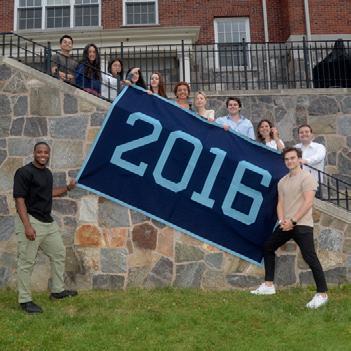
WIN A FREE REUNION WEEKEND
Become a Reunion Volunteer and get entered to win a free weekend stay—on us!
One lucky volunteer will have their campus lodging, meals, and activities fully covered by Kent during Reunion Weekend.
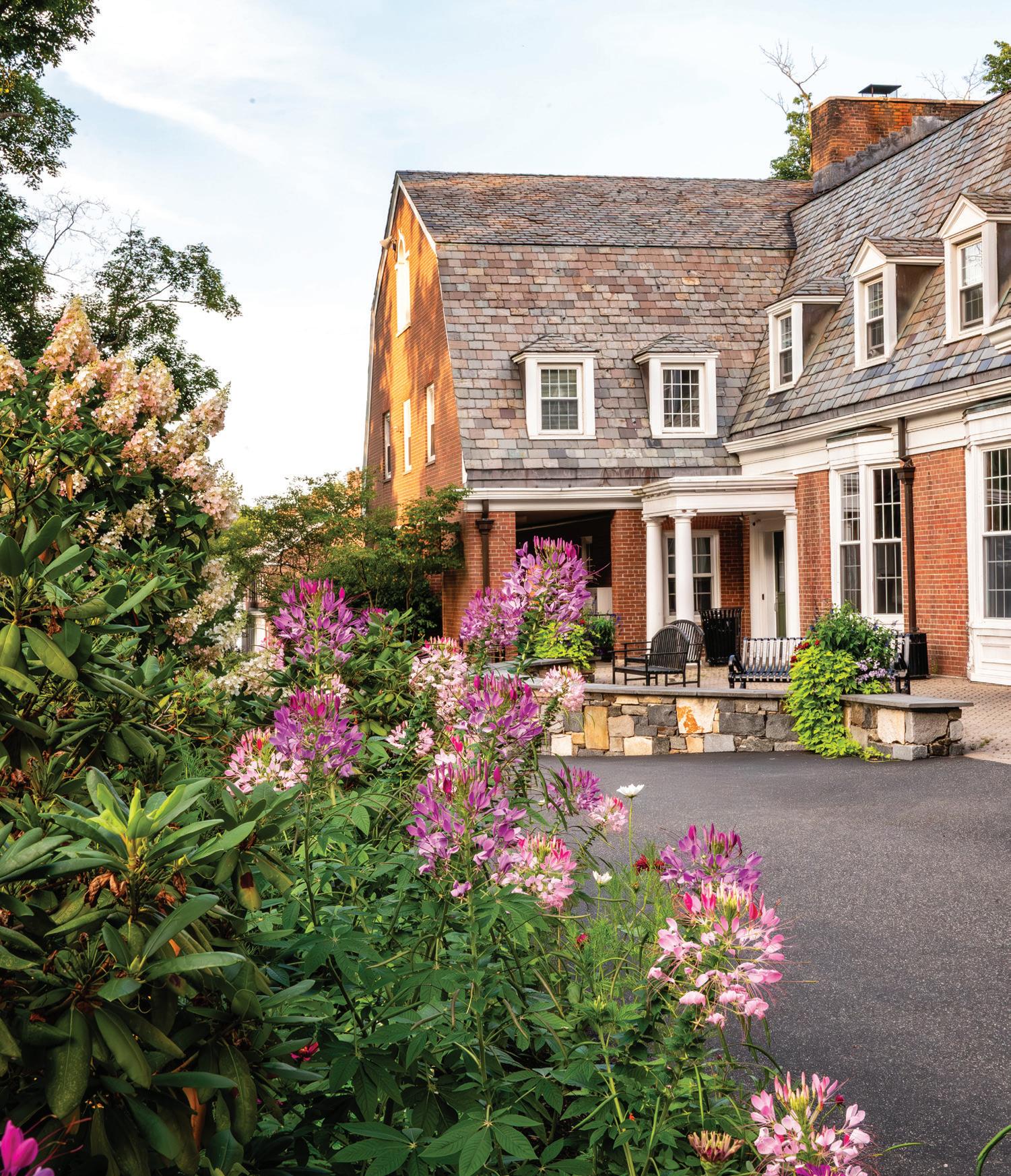
The blossoms of summer remind us that critical thinking provides the roots, while creativity lets us flourish.
P.O. Box 2006 Kent, Connecticut 06757
To support sustainability, we are now sending one issue per household. If this magazine is addressed to a family member who no longer lives with you, please email us with their updated address at alumni@kent-school.edu.

Kent’s Fall Calendar Highlights
September 26-28
Fall Alumni Weekend
Kent School
Hear from School leadership, attend classes and games, and more.
October 10-11
Family Weekend
Kent School
Hear from School leadership, attend advisory, classes and games, meet fellow Kent families, and more.
October 14-16
Gather & Give Online
During this giving day event, our alumni, families, faculty, and friends unite to fuel growth, honor tradition, and invest in the future of our students and school.
